The Lofoten Islands are one of the most beautiful places in the world: hundreds of islands scattered along the coasts of Northern Norway, jutting out into the ocean over 200 km north of the Arctic Circle. The main islands – nowadays connected by road bridges and underwater tunnels – are draped with tiny, quaint fishing villages overlooking one of the most fruitful fishing grounds in the North Atlantic.
The Lofoten Islands are the ideal destination for a memorable road trip, capable of enchanting and moving even the most seasoned travelers. In this guide you will find all the best things to do in the Lofoten Islands, the best places to see, the best hikes and all the best tips from the locals to better plan your trip. You’ll find a curated selection of the best places to stay – including traditional rorbuers, wooden fishermen’s lodges – and all the activities and tours you can’t miss, such as boat tours to the Trollfjord and Reinefjord.
What you will find in this guide to visiting the Lofoten Islands:
- Lofoten Islands: Things to Know Before You Go
- Lofoten Islands: Things to Do & Places to Visit
- Lofoten Islands Best Tours and Activities
- Lofoten Islands Northern Lights
- Lofoten Islands Beaches & Hikes
- How to Sleep in a Traditional Rorbu (a Must-do!)
- Best Time to Visit Lofoten Islands
- Lofoten Islands Daylight Hours: Sunrise and Sunset Calendar
- How to get to the Lofoten Islands
- Lofoten Islands Map
- FAQs about the Lofoten Islands
Lofoten Islands: Things to Know Before You Go
The Lofoten Islands are one of the most beautiful places in the world: a handful of large islands covered by green grasslands, remote valleys and over 160km of rugged mountains, the so-called Lofotenveggen (Lofoten Wall). Approaching from the south with the ferry from Bodø you will be left speechless. These islands seem straight out of a fairytale, with its tiny fishing villages, jagged high peaks – snow capped until early summer – and dozens of hidden bays and heavenly beaches.
The mountainous Lofoten Islands are set so close together that it is possible to drive continuously from northeast to southwest: the islands are crossed by the E10 – which here is called Lofoten Scenic Road – a wide and excellent panoramic road. The islands are connected by road bridges and underwater tunnels, with the exception of some small, remote islands, such as Værøy and Røst, located at the southwestern end of the archipelago.
This makes the Lofoten Islands the ideal destination for a road trip, which is why most visitors choose to fly and drive from the nearby airports of Bodø or Narvik, or from the small airports of Svolvær and Leknes, located on the archipelago.
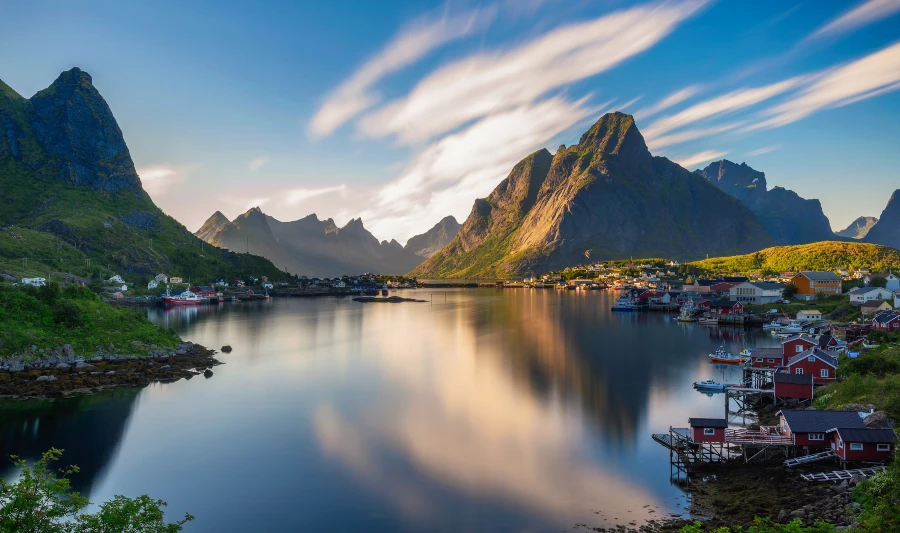
The Lofoten Islands hide hundreds of breathtaking straits, sounds and fjords, dotted with charming fishing villages, most memorably Reine, Å, Nusfjord and Henningsvær, as well as the towns of Svolvær and Kabelvåg. Even today you can be enchanted by the fascinating local culture, linked to fishing and crafts. You will be able to stay in one of the quaint wooden fishermen’s cottages, the so-called rorbuer, try delicious pastries freshly baked from old stone ovens, taste the renowned Lofoten fish oil, as well as enjoy the best of regional cuisine.
In winter, cod migrates from the Barents Sea to spawn around the Lofoten Islands, attracted by the waters mitigated by the Gulf Stream. The main fishing season lasts from February to April, when hundreds of fishing boats can be seen around the Lofoten Islands. Villages teem with fishermen and the wooden racks used to dry the cod are filled with odiferous fish. This is the stockfish of the Lofoten Islands, among the finest in the world!
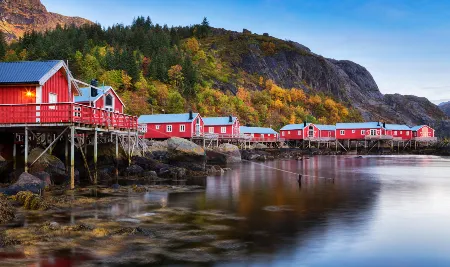
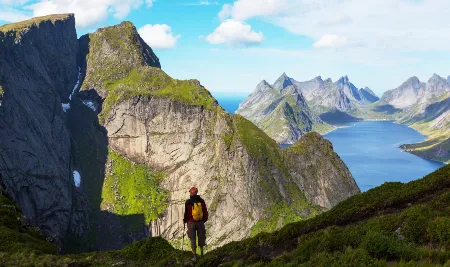
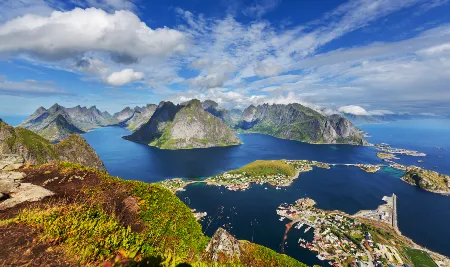
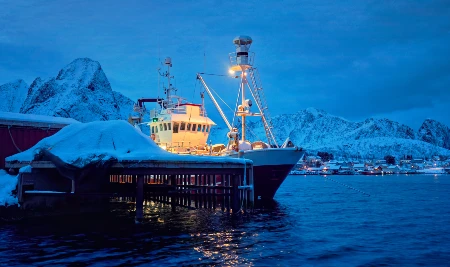
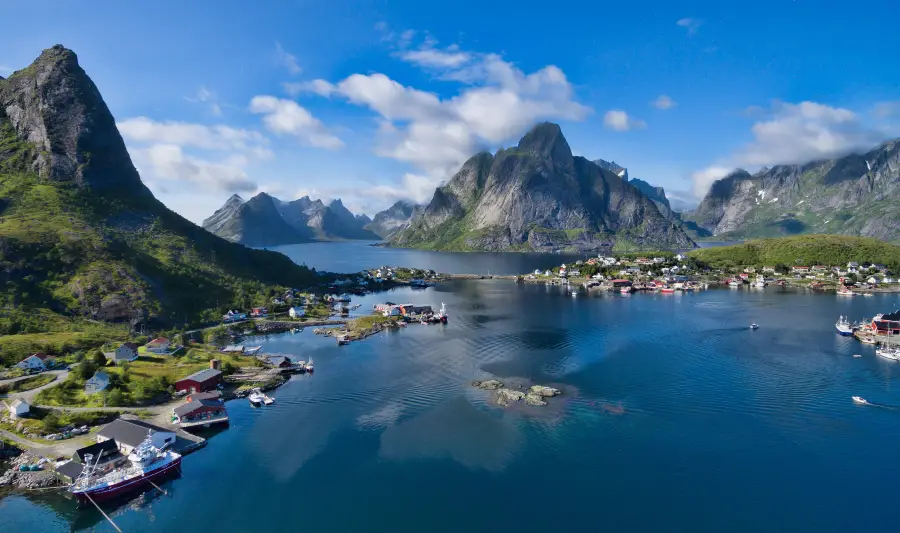
Local culture is closely linked to cod fishing, and the Lofoten Islands boast some of the best museums dedicated to traditional fisheries. However, Lofoten is also a paradise for hikers, cyclists, climbers and surfers. You will enjoy hundreds of miles of amazing hiking trails, as well as some of Norway’s best boat trips, such as those to the breathtaking Trollfjord and those in the fjords around Reine. You can join a traditional fishing trip or reach the more remote islands of Værøy and Røst, home to some of Norway’s most important puffin and seabird colonies.
Lofoten Islands Location and Practical Facts
The Lofoten Islands are located in Northern Norway, in the Norwegian Sea, about 200 km above the Arctic Circle. The archipelago includes hundreds of small islands and uninhabited islets, as well as 7 main islands. From the northeast to the southwest we find the islands of Austvågøy, Gimsøya, Vestvågøy, Flakstadøya and Moskenesøya, connected by road bridges or underwater tunnels. By ferry you can reach the two most remote islands, Værøy and Røst. Another smaller island – Skrova – can be reached by ferry from the town of Svolvær on the island of Austvågøy. The island of Austvågøy is connected with a road bridge to the island of Hinnøya, which is part of the neighboring Vesterålen Islands. From there a road bridge leads to the mainland near Narvik.

Lofoten Islands: Things to Do & Places to Visit
Svolvær – AUSTVÅGØYA ISLAND
Svolvær is the largest town of the Lofoten Islands, located on Austvågøya Island, in the municipality of Vågan. For many travelers, Svolvær is the gateway to the Lofoten Islands, as there is a small airport with some flight connections to Oslo and Bodø and the remote island of Røst. The port of Svolvær is also one of the most important of the faroes, here is the ferry terminal for Skutvik – on the mainland halfway between Bodø and Narvik – and the small island of Skrova. Hurtigruten ships call the port of Svolvær once a day northbound and one southbound.
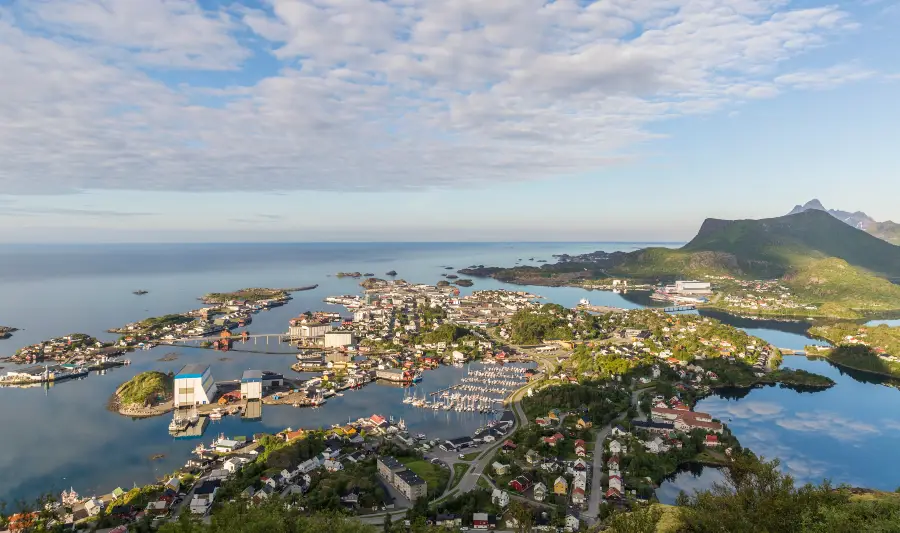
Svolvær is also an important stop for those on a road trip from Narvik, as it is located on the E10 – the main road of the Lofoten Islands – and is the gateway to the scenic southwestern part of the Lofoten Islands. Unsurprisingly, Svolvær has a wide range of good hotels and restaurants, mostly located within walking distance of the ferry terminal. But be warned, Svolvær is hugely popular in every season, so it’s best to book months in advance.
Svolvær is a nice town, located roughly in the middle of the Lofoten Islands and nestled between fjords and high mountains, such as the Fløyfjellet and its iconic Svolværgeita, a 150 meters high pinnacle located right next to Svolvær. This scenic mountain, characterized by an impressive vertical rock face and two horns, called Storhorn and Lillehorn. Hence the name Svolværgeita, which means Svolvær Goat, as it resembles the horns of a goat. Fløyfjellet mountain with its pinnacle reaches a height of 600 meters above sea level: climbing is possible with local guides, and once on the top it is customary to jump over a 1.5 meters wide gap from Storhorn to Lillehorn.
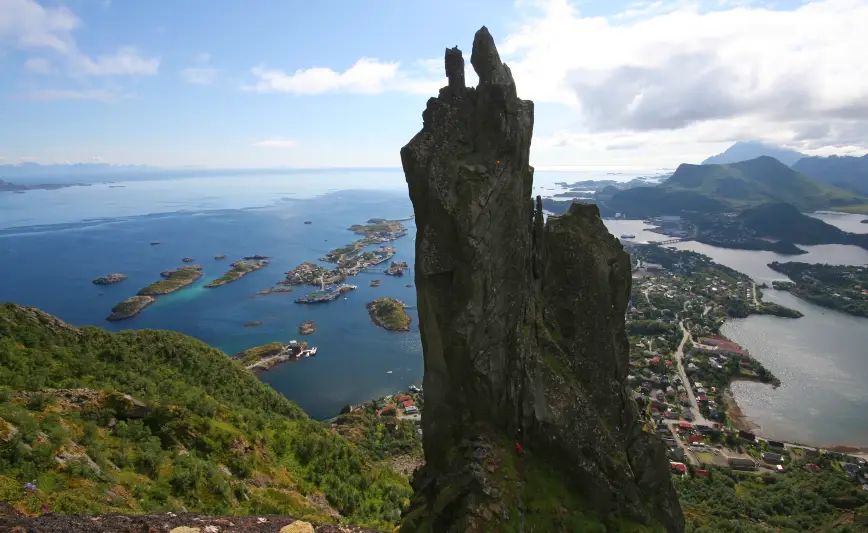
Around the harbor you can see dozens of traditional wooden houses, the characteristic rorbuer, which were once the fishermen’s houses. This type of house, usually built on water, is widespread in Northern Norway and especially in the Lofoten Islands, where you can see some of the oldest and most beautifully preserved. Some of these now house very characteristic hotels and guesthouses, such as Anker Brygge and Svinøya Rorbuer.
The town of Svolvær is quite modern, with several beautiful buildings in a contemporary Scandinavian style. You can get a glimpse with an easy walk from Småbåthavna, the marina located north of the city center, along Vestfjordgata road and the nearby promenade, located near the tourist office and the Hurtigruten terminal.
Don’t miss the Lofoten War Memorial Museum (Krigsminnemuseum), located inside the former post office. This small but very interesting museum boasts an impressive collection of WWII and Nazi occupation memorabilia. You will be able to see various authentic uniforms, objects, photographs, tools, weapons, documents and medals. The museum and its passionate staff are one of the best things to do in Svolvær, even if you’re not big war buff.
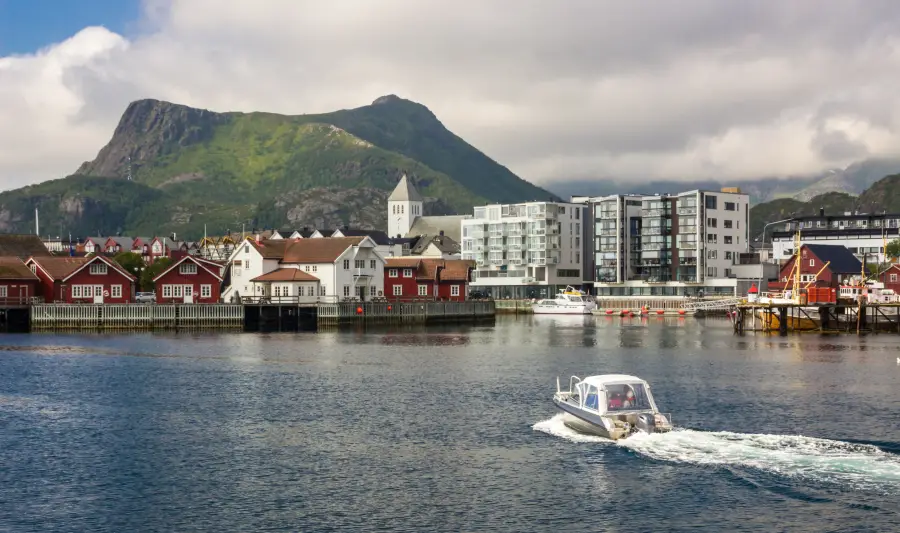
The area around the Hurtigruten terminal is the real heart of Svolvær: here are several restaurants, shops and pubs, as well as some of the most popular hotels, such as the Thon Hotel Svolvær, the Scandic Vestfjord Lofoten and the Thon Hotel Lofoten. Nearby you could visit the Magic Ice Lofoten, which is both an ice bar and a gallery displaying nice ice sculptures. Located in a former fish freezing warehouse, it boasts hundreds of ice sculptures, including furniture, tables and glasses. The entrance fee (NOK 250) includes a drink. Svolvær is also populated by artists and artisans, you can see and buy their works in the various art galleries around the Hurtigruten terminal.
Some of Svolvær’s most popular activities and day trips also depart from here, such as a boat ride to the breathtaking Trollfjord and traditional fishing trips.
An easy walk to nearby Kuba Island, connected to Svolvær by bridges, will allow you to see the Kjeøya Kystbatteri, a couple of several old rusty and derelict WWII bunkers and artillery posts. Right around you, you’ll see dozens of huge wooden pyramid-shaped racks called hjell, used to hang cod for drying.
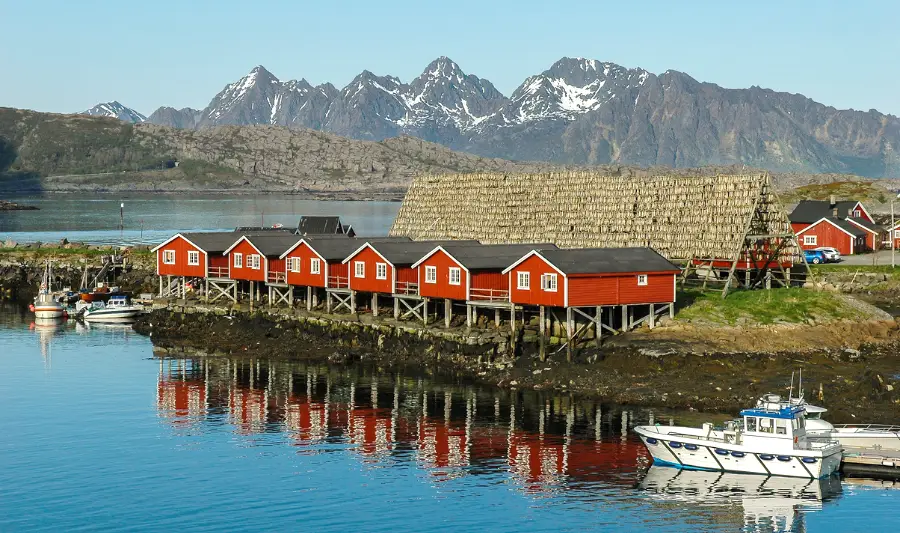
The drying of cod and stockfish in Lofoten is done in a very traditional way, simply by hanging the fish in the cold and salty arctic wind. Fish flakes are widely scattered only in the landscape of the Lofoten Islands, you will commonly see them along the beaches and rock formations along the coast. In early spring they will probably be loaded with fish hanging out to dry. Beware, the smell could be overwhelming for those who are not used to it. But for the locals, it’s a lovely smell! Just to say, the fish hanging to dry around the Lofoten Islands is worth millions of dollars on the market!
On the southern tip of the island you can see a small sculpture called Fiskerkona, the work of the Norwegian artist Per Ung, which represents a woman waving nostalgically to the sea. She is said to be greeting her husband, a fisherman. The statue now greets all sailors, fishermen and travelers who leave the port of Svolvær. The statue also serves as a harbor light. To reach Fiskerkona and the fish flakes the road passes through a couple of warehouses and factories. There are no signs, so don’t be put off by the uninviting appearance of the area.
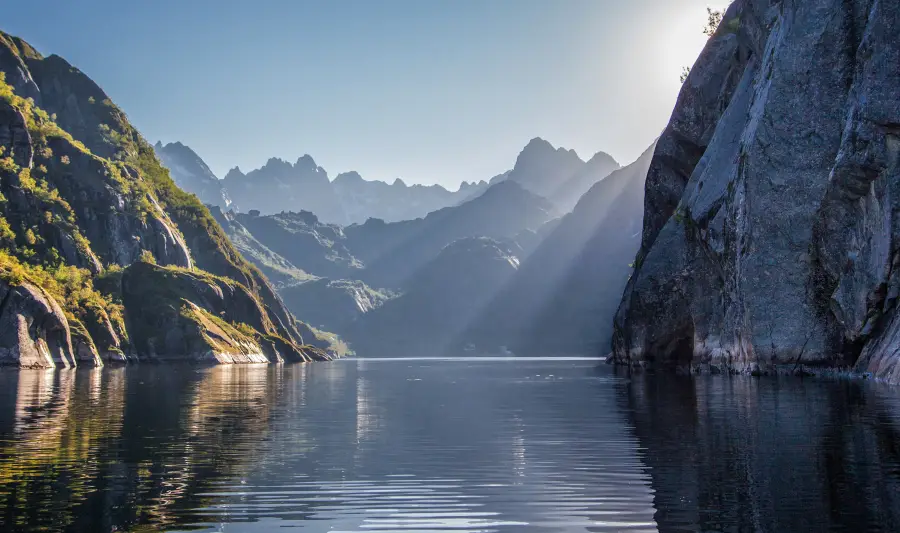
Trollfjord – AUSTVÅGØYA ISLAND
Svolvær’s main attraction, and one of the must-do on a trip to the Lofoten Islands, is a boat ride to the stunning Trollfjord. The large island of Austvågøya, which is the largest of the Lofoten Islands, is separated from the neighboring Vesterålen Islands only by the narrow Raftsundet strait. Here, in a rather remote and wild corner, is one of the most beautiful and famous fjords in Norway: the Trollfjord.
This narrow fjord – accessible only by boat – is 2 km long and just 100 meters wide. It is nestled between scenic mountains over 1000 meters high, and impressive rock faces that are home to a large number of rare seabirds. Sometimes the big Hurtigruten ships enter the fjord to allow travelers to admire it: the ship barely manages to pass through its narrow mouth.

However, the Trollfjord remains one of the most remote places in the Lofoten Islands: one of the best ways to explore it is by small RIB boats that allow small groups to admire the breathtaking landscapes and observe wildlife, including sea eagles – which boast the largest wingspan in the world, reaching a maximum length of 2.65 meters – and the swimming seals. Tours are very popular and only allow a small number of travelers per day, so booking well in advance is recommended.
KABELVÅG – AUSTVÅGØYA ISLAND
Located just 5km southwest of Svolvær, Kabelvåg is one of the oldest towns on the Lofoten Islands. It is smaller but also more attractive than Svolvær. From Viking times until the early twentieth century, this was the most important village on the Lofoten Islands. It is in Kabelvåg that the first fisheries on Lofoten were set up, almost 1000 years ago!
Norway’s first rorbuer was built here in 1120, as well as one of its earliest inns, dating from 1792. Today it is a pleasant and quiet town, boasting a pretty old town with brightly painted timber houses draped around a narrow inlet.
The main attractions are located just outside the city center. A little to the north is Vågan Church (Vågan Kirke), also known as the Lofotkatedralen, a majestic church built in 1898, famous for being Norway’s second-largest wooden church. It is capable of hosting over 1200 people, probably more than the entire population of the village.

The quiet neighborhood of Storvågen, located just west of the city center, is home to most of the attractions, set side by side. A combined ticket (starting at NOK 260) will allow you to enter the town’s three museums, the Lofoten Museum, the Lofoten Aquarium and the Espolin Gallery. If you are not an art lover you could skip the Espolin Gallery and buy the tickets separately.
The interesting Lofoten Museum (Lofotmuseet) is the islands’ major folk museum, and is located on the site of the medieval town of Vágar, the oldest town on the Lofoten Islands. It is set in an old house from 1815, which was the home of Caspar Lorch, who was the owner of the fishing village. It is the best place to get an insight into the local history and culture. You will find out how life was in the Lofoten Islands at the time, how a fishing village worked, what rorbuer were and what they were used for and other interesting facts.
Right next door is the Lofoten Aquarium (Lofotakvariet), one of the most interesting attractions in the Lofoten Islands, especially for families. This aquarium is dedicated to Arctic wildlife and fish that inhabit the waters around the Lofoten Islands and the Arctic Ocean. You will be able to see dozens of species of crustaceans and fish that live in the depths of the ocean, as well as some aquatic mammals. There are also some exhibits on fisheries and aquaculture. The highlight is the feeding of seals and otters, which usually takes place around noon.

Opposite the Lofoten Aquarium is The Espolin Gallery, an art gallery displaying a collection of works by Kaare Espolin Johnson, one of Norway’s most prominent painters. Espolin’s works are inspired by Arctic landscapes, especially those of the Lofoten Islands. His paintings and sketches are imbued with dark atmospheres and ungainly faces. His technique is quite eclectic, based on a mixture of watercolor, oil, lead and soot. The gallery unfolds over three rooms, one of which hosts temporary exhibitions.
The three museums are quite small, and you can visit them all in 2 or 3 hours. Within walking distance of the museums, climb Nyvågar for good views of the fjord and the village. Here is also one of the most beautiful hotels in Kabelvåg, Nyvågar Rorbuhotell, which offers nicely renovated rorbuer accommodation, and also boasts a nice spa and good restaurant. Other great accommodations nearby are the Skårungen Hotel, Cabins and Camping and the beautiful apartments and lofts with scenic sauna and views at Lofoten Apartments.
Henningsvær – Heimøya and Hellandsøya Islands
One of the most famous places in the Lofoten Islands is Henningsvær, located 25 km southwest of Svolvær. This town spans two small islands – Heimøya and Hellandsøya – connected by a road bridge to the island of Austvågøya. You have probably seen one of the most famous pictures of the Lofoten Islands showing a town spread over several islands, with a football field nestled on one of them: this is Henningsvær.
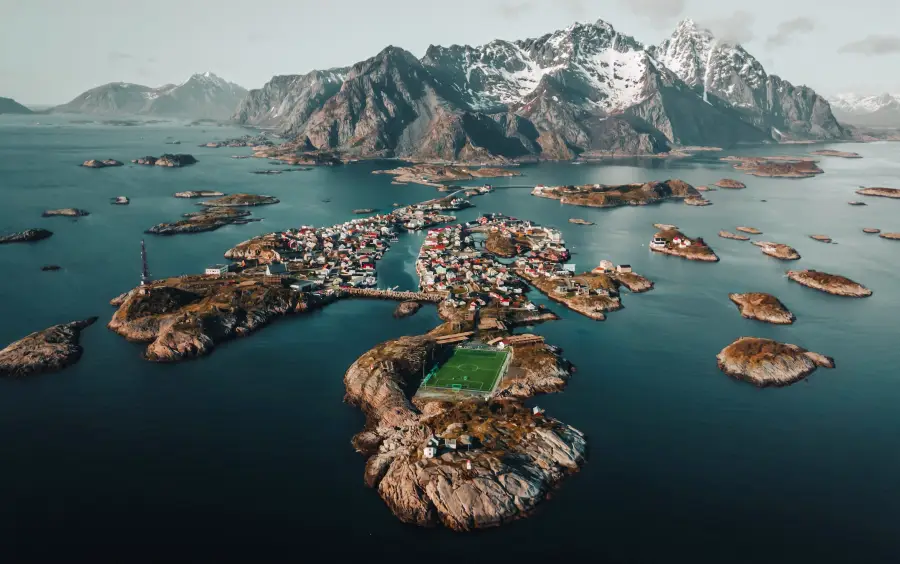
This quiet town boasts an old town and a small harbor featuring dozens of typical traditional fishermen’s cottages and several good cafes and restaurants. Take a break at Henningsvær Lysstøperi and Cafe for a coffee and a good freshly baked pastry. The town is renowned for its cod fishing and there are a couple of good restaurants serving excellent seafood, fish soups and great local cod specialties, such as Restaurant Lofotmat and Fiskekrogen Henningsvær.
The coolest place to stay and go for a drink or a bite is the Trevarefabrikken which is a fusion of an eclectic hotel, restaurant, bar and cultural and arts center, very popular with locals. This place embodies the essence of Henningsvær: it is an old fish factory, artistically renovated, preserving some of its old industrial charm.
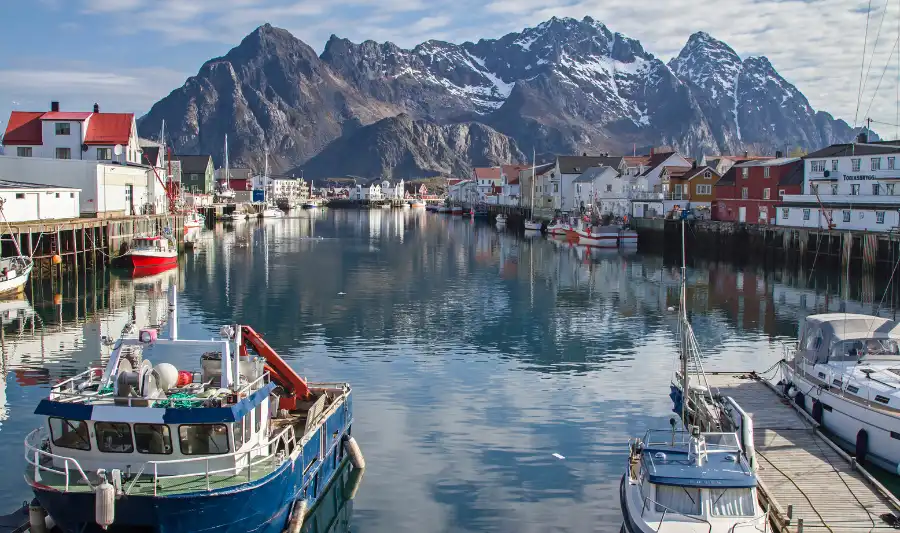
Henningsvær is in fact one of the liveliest towns of the Lofoten Islands and boasts several art galleries, such as Galleri Lofotens Hus, artisan shops, such as Engelskmannsbrygga and also an interesting contemporary art museum, the KAVIARFACTORY, set in what once was a caviar paste factory.
One of the best views is from the Dreyers gate, the bridge that connects the two islands, located at the south end of the town. From here you will have a nice view of the harbor and its traditional houses, with the mountains in the background.
Reine – Moskenesøya Island
The most iconic place in the Lofoten Islands is Reine, a small village located on Moskenesøya Island, at the southern end of the Lofoten Islands. Reine is a tiny fishing village with a picturesque harbor lined with dozens of rorbuer, located about 5km north of the town of Moskenes.
The enchanting picture of the red wooden houses scattered on a maze of small islands, overlooking the turquoise sea and dominated by high snow-capped mountains has become synonymous with the breathtaking landscapes of the Lofoten Islands. Unsurprisingly, Reine is also one of the most famous and touristic places in the archipelago.
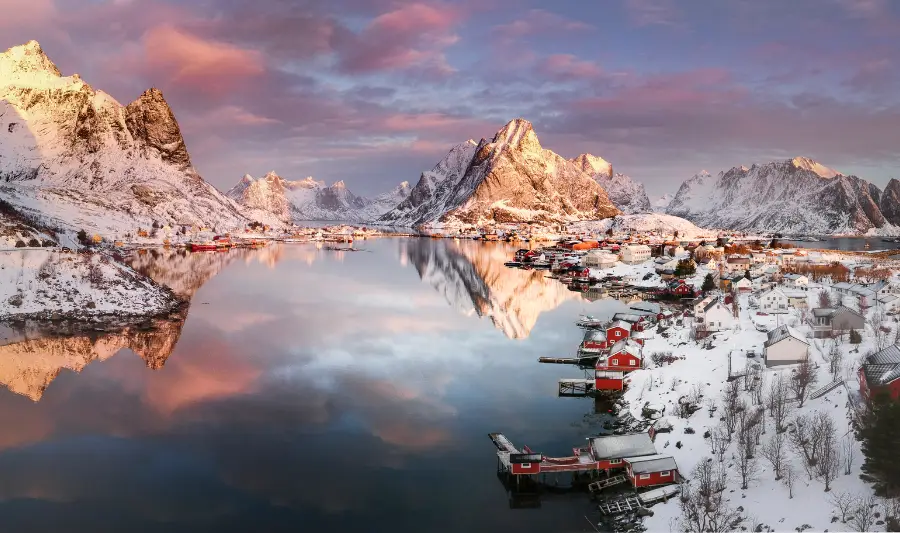
Being located along the E10 road and close to the Moskenes ferry terminal, where ferries from Bodø arrive and depart, Reine is a perfect place to explore the southern Lofoten Islands. In addition, the views are fabulous in both summer and winter, making it a favorite destination for photography enthusiasts. Around Reine there are several viewpoints, and the views in summer benefit from the beautiful colors of the forests, the crystal clear sea and the bright colors of the village, while in winter you will have a magical and evocative atmosphere, with snowy landscapes, the lights filtering from the rorbuer windows and maybe even sensational northern lights.
Reine overlooks the beautiful Reinefjorden, one of the most scenic fjords of the Lofoten Islands, with memorable mountain formations, high peaks, waterfalls, shallow turquoise waters, and small fishing villages. The fjords in the area can be explored with comfortable and inexpensive boat trips from Reine.
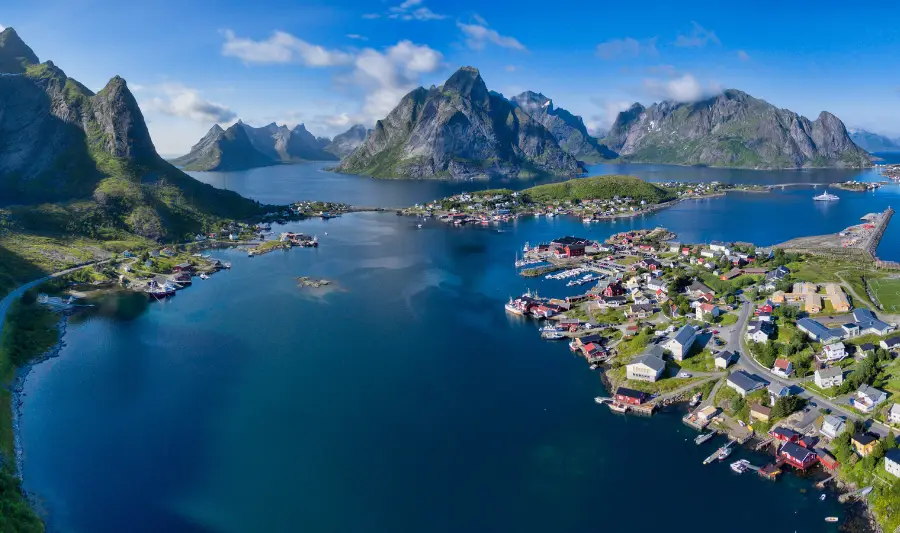
In the background of the village is Mount Reinebringen which offers many opportunities for hiking. The most popular and easy hike from Reine is to the Reinebringen Viewpoint, from which you can get the best view over Reine and the islets towards Hamnøy. To get there you should park in the parking lot (free, max 4 hours) at the entrance to the village (GPS: 67.92876, 13.08531) and walk along a path that leads to a staircase. There are about 1900 steps to get to the top. The view from the top is sensational! Wear good hiking shoes and layered clothing. Rocks and steps, especially at the top, can be slippery and there is a risk of falling. The hike is easy, but it requires you to be a little fit.
For art lovers, the Reine Center of Arts and Culture, located in the former school in the heart of Reine, hosts a permanent exhibition on the Norwegian artist Eva Harr and temporary exhibitions of art and photography.
Reine and the nearby village of Hamnøy are the most beautiful places to stay in the Lofoten Islands. No trip to Lofoten is complete without staying in one of the fabulous rorbuers overlooking the idyllic Reinefjorden and surrounded by mountains.
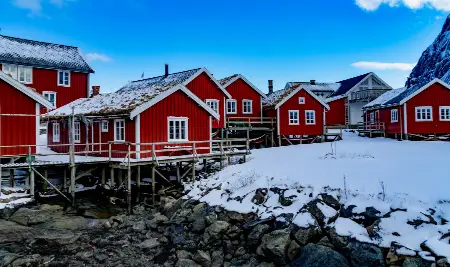
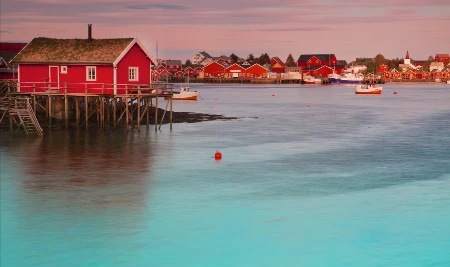
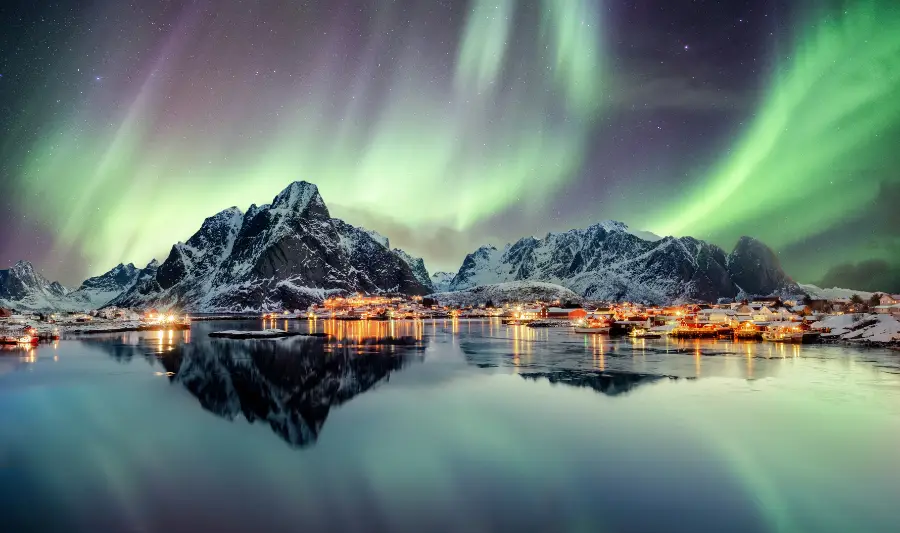
The most beautiful places to stay in Reine and Hamnøy: stay in the most iconic place in the Lofoten Islands
Reine and Hamnøy‘s rorbuers are authentic and finely restored, they are set in one of the most scenic corners of Norway and keep their old charm practically intact. What was once a remote Arctic fishing village, today is the ideal place for a dream stay, to enjoy unforgettable landscapes in the summer and, perhaps, the Northern Lights in the winter.
One of our favorite places is Reine Rorbuer by Classic Norway Hotels. Also fabulous are the rorbuer of Valen Cabins in Reine and the iconic orange Sakrisøy Rorbuer. These places boast cozy rooms, in traditional wooden houses, with stunning views.
Other great alternatives can be Olstind in Sakrisøy, Rostad Retro Rorbuer, Eliassen Rorbuer and Toppøy Rorbuer. If you are looking for a luxurious stay, then you should check out Lofoten luxury home with sauna: a fabulous modern Scandinavian-style villa, equipped with every amenity and a mind-blowing view.
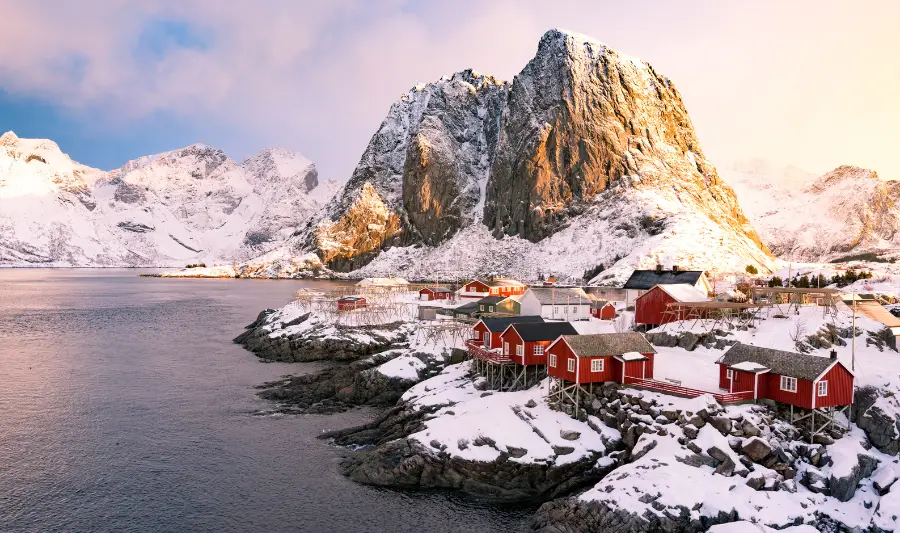
Hamnøy – Moskenesøya Island
Another popular view of the Lofoten Islands is from Hamnøy, a small fishing village located just north of Reine. In fact, from Hamnøy you will be able to see Reine in the background and vice versa, however the view is amazing!
Located right along the E10 road, Hamnøy sits right on the Reinefjorden and is connected to the other small surrounding islands by road bridges. For the best view, walk a few hundred meters over the road bridge to nearby Toppøya Island. You can stop here and take one of the most iconic pictures of the Lofoten Islands, with the traditional red houses of Hamnøy at the foot of the mountain. You will have to walk there, as it is not possible to stop by car. Another good viewpoint is just after the bridge, there is a space on the right where you can park and enjoy the view.
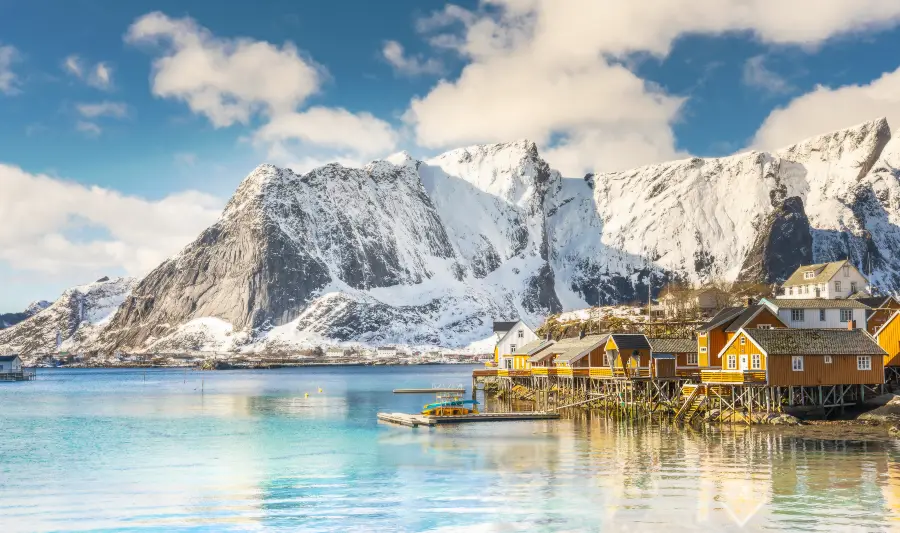
Sakrisøy – Moskenesøya Island
Located between Reine and Hamnøy, the tiny village of Sakrisøy sits on a small island connected by road bridges to the other two villages. It is also located along the E10 and is characterized by its yellow-orange wooden houses overlooking the emerald sea.
A few steps away, on the neighboring island Olenilsøya, there is a hill from which you can have a beautiful 360° view over the three villages of Sakrisøy, Reine and Hamnøy. The top of the hill can be reached with an easy walk which is also suitable for families. All around you will be able to see dozens of hjell, the famous drying racks. In the spring you can find them full of cod hanging out to dry, while in the summer you will probably only see the cod heads.
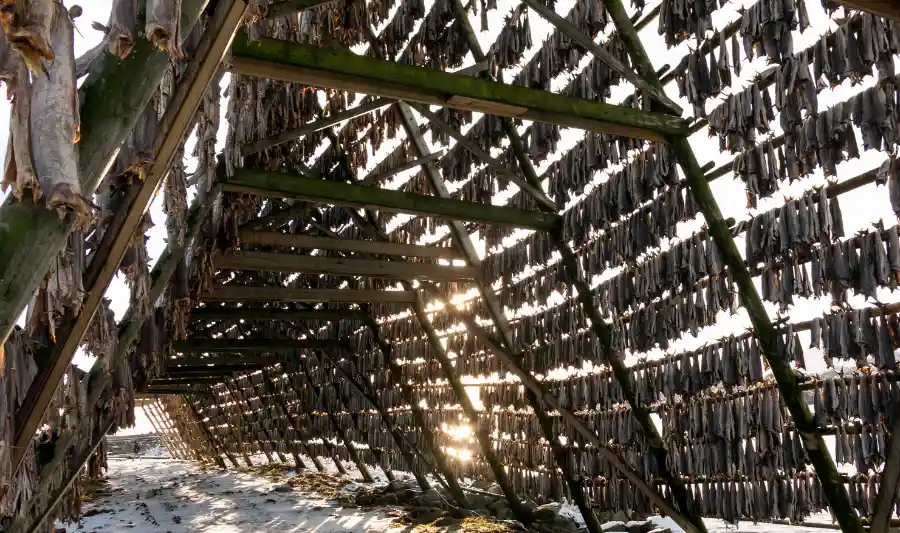
Why do they dry fish heads in Norway? Despite the fact that Norwegians do not eat cod heads, they are commonly preserved and perfectly dried. This is because in some cuisines of the world, such as in Asia and Africa, cod heads are used as an ingredient for traditional recipes. So the local fish industry will sell these dried cod heads mainly to Nigeria.
Sakrisøy as well as for its yellow-orange rorbuer – which are now finely restored and house the Sakrisøy Rorbuer, the Olstind in Sakrisøy and the nineteenth-century Sakrisøy Gjestegård – is also famous for its quirky Dagmar’s Museum of Dolls and Toys, a small private museum displaying a huge collection of old toys and dolls, and for Anita’s Sjømat (Anita’s Seafood), a shop selling the best local fresh fish. Here you can buy authentic local stockfish and dried cod, as well as salted cod, halibut, caviar, smoked salmon, pickled salmon and even smoked whale. They also serve good fishburgers, sashimi and soups. Prices are not cheap.
Å – Moskenesøya Island
World famous for being the town with the shortest name, the village of Å – often also referred to as Å i Lofoten, to distinguish it from the homonyms – is at the southern end of the Lofoten Islands, about 5 km south of Moskenes (where ferries arrive from Bodø) and 10 km south of Reine.

Å is the end of the E10, the road that runs through all the Lofoten Islands. The E10 will be the cornerstone of your Lofoten Islands road trip, as most of the attractions are along it. You could drive non-stop from the mainland – from Narvik, for example – to Å, passing from one island to another in the archipelago thanks to dozens of road bridges. In fact, this scenic road – which is among the most beautiful in the world – starts in Sweden, in the town of Luleå, and runs 850 km to Å, passing through Kiruna, Abisko and Narvik. Incidentally, Å is also the last letter in the Norwegian alphabet.
The small and peaceful village of Å may be the beginning or the end of your road trip to the Lofoten Islands, however you will be delighted by the beautiful landscapes you will enjoy along the way. Its relaxed and old-fashioned atmosphere, with its red wooden houses, the small harbor and the dozens of fish drying racks, make Å one of the most authentic and remote destinations of the Lofoten Islands.
In Å, there are also some of the most interesting museums in the Lofoten Islands, such as the Norwegian Fishing Village Museum (Norsk Fiskeværsmuseum), which is a great place to learn more about the local culture. You will be able to discover what life was like on the Lofoten Islands until a few decades ago, see the authentic interiors of houses and shops of the time, a boathouse and a post office.




However, the most famous attraction is its old fish oil refinery: you will be able to see how the original Norwegian cod liver oil was made, which was considered a fundamental supplement for children in Northern Europe, mainly due to their low exposure to the sunlight. You can also taste it and buy a bottle. You will be able to see the old forge where fish oil lamps were made, and finally be sure to visit the bakery.
The fragrant scent of freshly baked pastries hovers in the air around Bakeriet på Å, one of the must-see stops on your trip to the Lofoten Islands. In this bakery – in business since 1842 – breads and pastries are baked like in the old days, in an old stone oven from 1878. The prices aren’t cheap, but their cinnamon rolls (kanelsnurrer) are some of the best you can get around. Lofoten Islands. It is only open from June to mid-September.
Another interesting museum is the Lofoten Stockfish Museum (Lofoten Tørrfiskmuseum), located in old fish warehouses overlooking the sea, in the traditional style of Lofoten fisheries, similar to that of fishermen’s houses. This museum is the best place to learn more about stockfish fishing and processing. You will be able to see artifacts, tools, photographs and videos that show how local fishermen have carried out this craft for centuries.

In the nearby village of Sørvågen, located a couple of kilometers from Å, the Sørvågen Radio museum is worth a visit. Located in the former telegraph station and telephone exchange, dating back to the early 1900s, this museum allows you to see the original equipment and learn more about the fascinating history of this remote telegraph station, the first in Northern Europe to send wireless Morse signals.
In fact, the Lofoten Islands at the time were a remote land occupied by fisheries and fishing villages, mostly inaccessible except from the sea. For this reason, in the mid-19th century a special submarine telegraph line was installed, which was Norway’s first fisheries telegraph service. However, this only managed to connect a few villages, so at the beginning of the 1900s they began to experiment – for the first time in Norway and Northern Europe – wireless Morse communication, right in the Sørvågen Station. You can discover the rest of the story by visiting the museum. Open only from June to August.
The area around Sørvågen and Å offers various hiking opportunities. The most popular is the Tindstinden hike, which leads to waterfalls and some beautiful lakes. The first part, up to the waterfalls and the first lake is easy (about 15 minutes one way). The path continues towards the lakes and is sometimes steep, muddy and slippery. It takes about 3 hours (one way) to the Munkebu hut. You will skirt several lakes, such as Fjerddalsvatnet and Tennesvatnet, but with a short detour you can also reach Krokvatnet. The hike is medium difficulty, it could be strenuous for those who are not used to it and requires good waterproof hiking shoes. The weather could quickly turn bad, with rain and heavy wind, so be prepared.
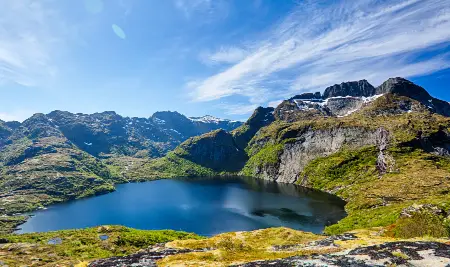
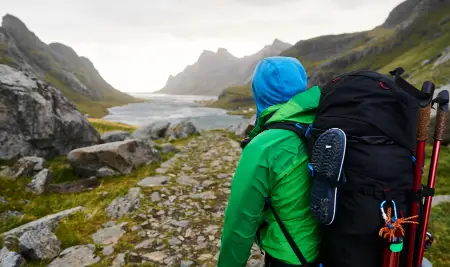

Around Å there are several good traditional rorbuer accommodations which are very popular with those arriving or departing from the Moskenes ferry terminal. Among the most popular are Å-Hamna Rorbuer, Å Rorbuer and Salteriet. The modern and comfortable rooms of the Lofoten Planet BaseCamp are also very good, as are the design rooms of the Holmen Lofoten, which also boasts a great restaurant serving regional cuisine.
Backpackers will appreciate the affordable dorm-beds accommodations (female-only or male-only) and basic private rooms with shared bathroom at the Lofoten Å HI hostel, which is one of the few hostels in the Lofoten Islands.
Nusfjord – Flakstadøya Island
The small fishing village of Nusfjord is one of the oldest and best-preserved in Norway, located on the shore of a quiet and remote fjord in the south of the island of Flakstadøya. To get there you will have to take a short detour from the E10. From the crossroads (GPS: 68.07245, 13.33373) the scenic Fv807 road runs for 6 km along a maze of lakes and along the shore of the fjord, until it reaches Nusfjord.
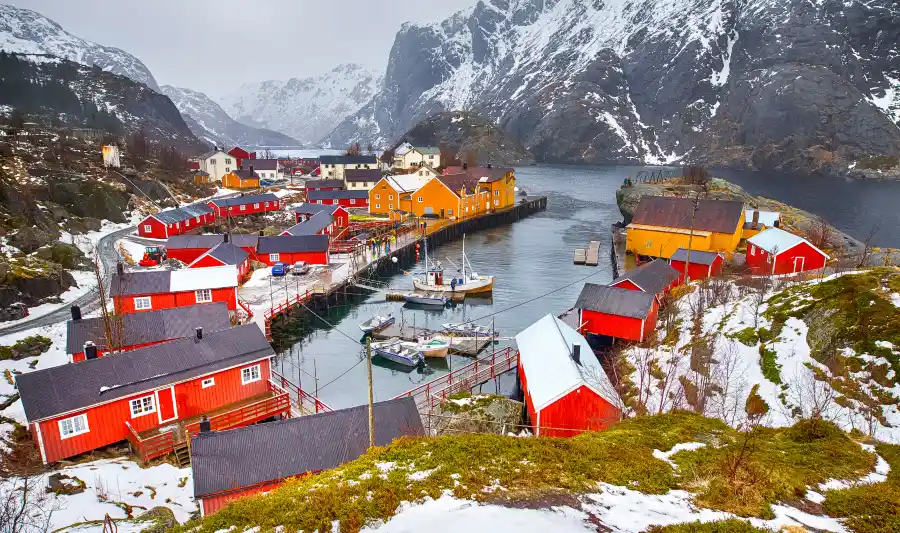
Nusfjord is an old fishing village dating back to the early 19th century. It was owned by the fisheries of the Dahl family, who owned it from 1847 to 2005. The fishing areas around the Lofoten Islands attracted several fisheries who built fishing villages to house fishermen, warehouses, trading posts and fish processing. The port was the only access route to the village, as the first road only arrived here in the late 1960s.
In the early 1900s, during the fishing season about 1500 Lofoten fishermen operated out of Nusfjord. Many of them slept crammed into rorbu cabins with other fishermen. The rorbuers were basic, dirty and smelly and were painted red mainly because red paint was the cheapest. There were about 50 rorbuer clustered around the harbor, today most have been finely restored and offer luxury and comfort that fishermen could never dream of. But from the outside, everything looks just like old times.
The village of Nusfjord has been restored since 1975 with the help of UNESCO, and today is one of the rare opportunities to see what life on the Lofoten Islands used to be like. The port of Nusfjord offered a natural shelter from storms to fishing boats, while around it are still visible the boat sheds, dating back to the mid-19th century, which preserve some authentic boats and fishing equipment.
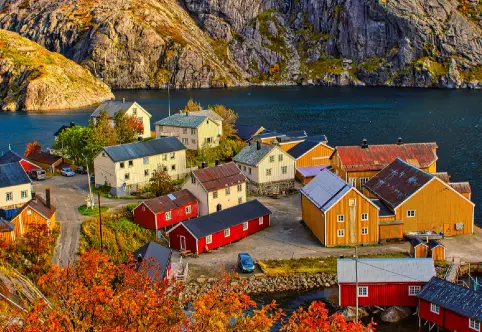
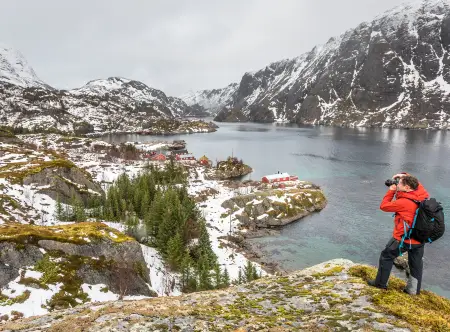
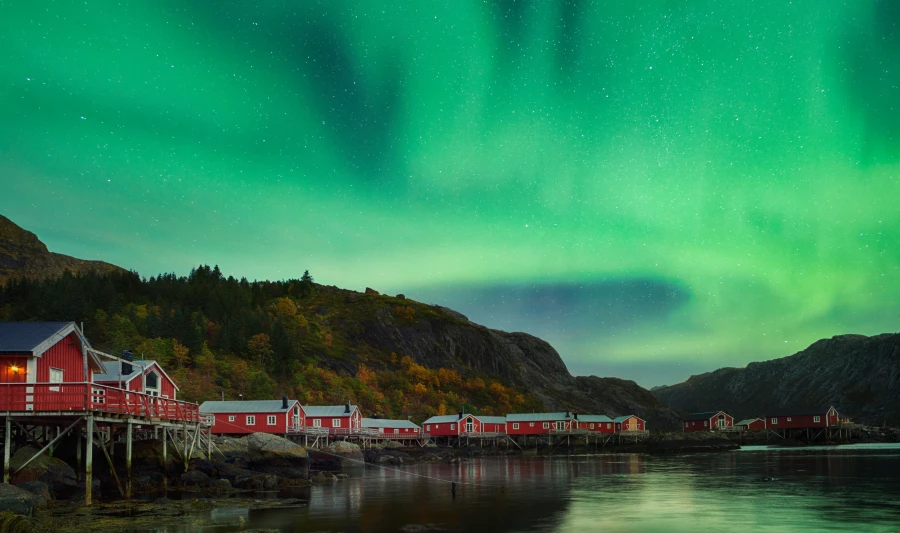
The old bakery, active since 1877, supplied fishermen with fresh bread, biscuits and pastries. Still today it bakes bread and pastries from the old wood-fired stone oven. Once the oven was heated mainly with off-cuts from the nearby sawmill. The delicious cinnamon rolls (kanelsnurr) and other freshly baked pastries are worth trying, as well as the solbollers (try the ones with rhubarb jam, my favorites), the skillingsboller with cream and vanilla and the famous skolebrød.
You will also be able to visit an old cod-liver oil factory, which was active from 1910 to 1990 producing high quality oil for medicinal use and a lower quality of oil used for paint and lubricants. The factories in the village were powered by a small hydroelectric power station located along the slope near the current parking lot, fed by the emissary stream of nearby Lake Nervatnet. With a short and easy walk you can reach the lake and enjoy the beautiful landscape. You will also see an old smokehouse, once used for smoking salmon.
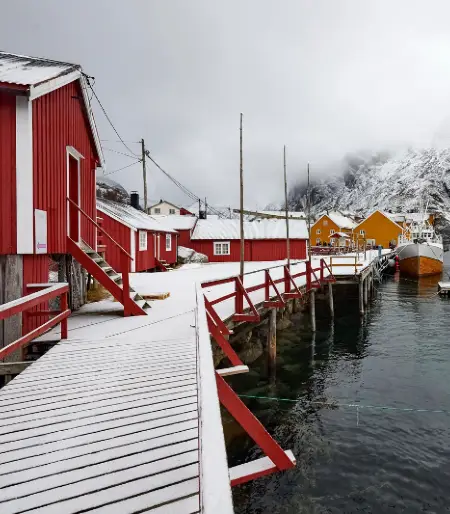
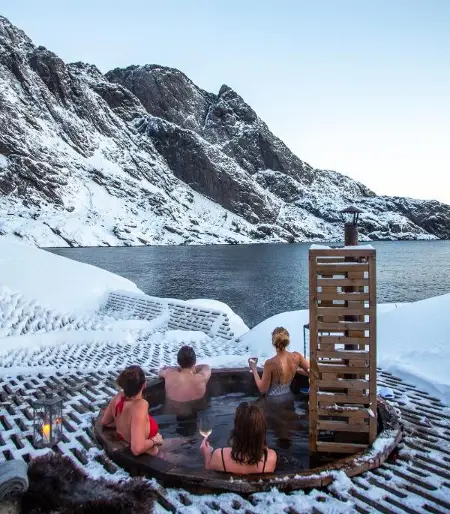
Nusfjord is surrounded by mountains, lakes, high cliffs and wilderness. This makes it very photogenic, and it’s one of the nicest places to stay. In fact, since 2005 the fisheries have been closed, and the village has mostly been finely restored. You will stay in one of the fabulous traditional fishermen’s houses at Nusfjord Arctic Resort. Don’t miss their wood fired hot tub with stunning fjord views and the opportunity to enjoy a rejuvenating break in their open-air spa and sauna. They are included in the room rate, as well as the excellent breakfast and private parking. In the heart of the village there is also the Karoline Restaurant, which serves great local cuisine.
To visit Nusfjord you will have to pay an entrance fee of NOK 100, except for hotel guests.
Vikten – Flakstadøya Island
Flakstadøya is one of the largest islands in the Lofoten Archipelago and is mainly characterized by wilderness, mountains, tiny fishing villages and several scenic beaches. The small village of Vikten is the northernmost of Flakstadøya, and can be reached with a short detour from the E10.
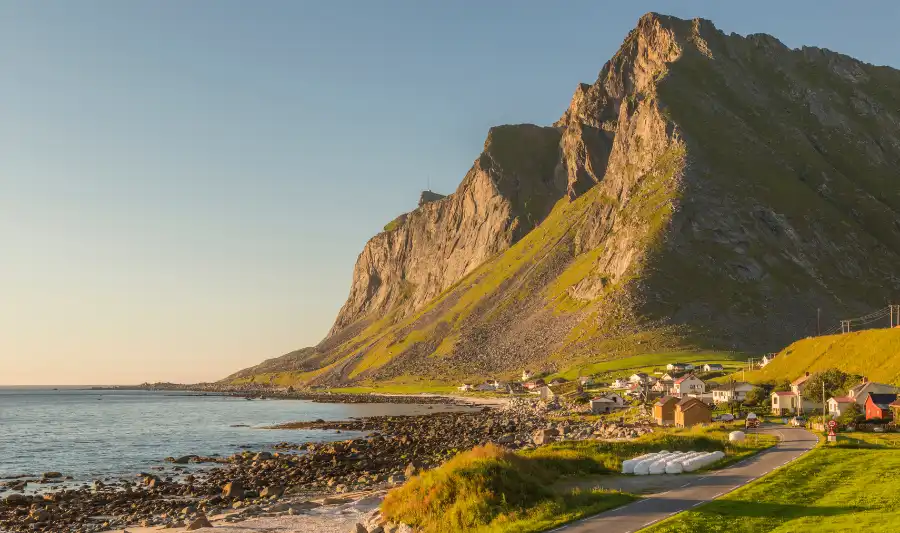
Vikten itself has no particular attractions, just a few houses overlooking a desolate beach. The reason to get here is to take a look at Glasshytta Vikten, an artisan glass factory founded in 1970 by Åsvar Tangrand and now run by his son, Anders Tangrand. You will be able to see the artist at work and witness the production of artistic glass and pottery. You will learn more about glassblowing and see the old glass melting oven.
The vases and glass objects made here are for sale in the shop next to the workshop, where you can also find a café with a nice ocean view. Among the glass souvenirs you can buy is the Lofotruna, which is the symbol of the Lofoten Islands. Some of the works are made with quartz extracted from the mountain behind Vikten. Glasshytta Vikten is open from May to August.
Sund – Flakstadøya Island
The southernmost village on Flakstadøya Island is Sund, which can be reached with a short detour from the E10. The road to Sund is taken near the road bridge that connects Flakstadøya to Moskenesøya, near the village of Mølnarodden.
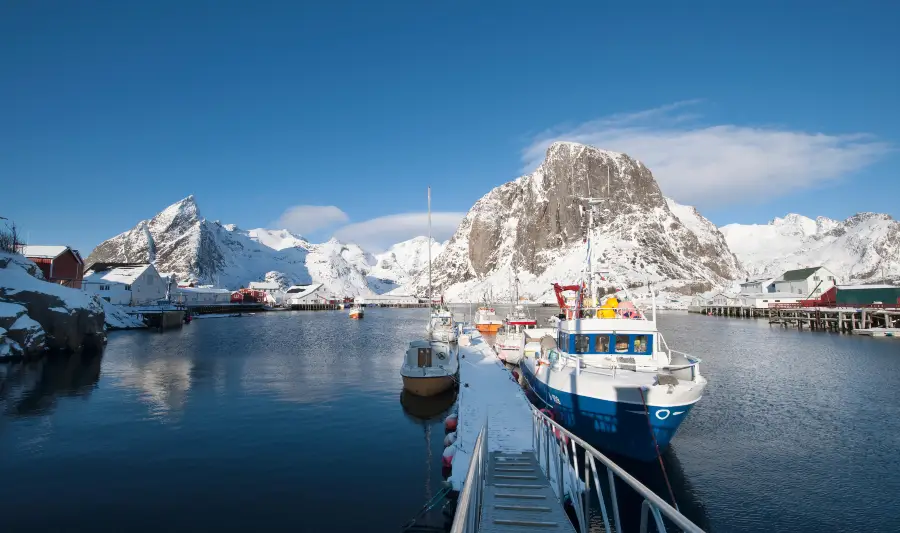
There isn’t much to see in Sund either – it’s just a tiny, desolate village overlooking a scenic natural harbor. The main attraction of the village is Smeden i Sund (The Blacksmith at Sund), a traditional forge where you can see the blacksmith at work, as he creates finely decorated iron art. You will learn a lot about this ancient art, as the blacksmith is usually willing to answer questions from visitors. You will also be able to purchase one of its famous wrought iron cormorants. Next to the blacksmith there is a small museum which exhibits engines and parts of old boats. The blacksmith and the museum are only open in summer.
Fredvang – Flakstadøya and Moskenesøya Islands
Close to the village of Ramberg on Flakstadøya Island, a short detour from the E10 to the village of Fredvang, located at the northern end of the Moskenesøya Island, is worthwhile. The Fv808 road to Fredvang crosses the fjord passing through a couple of islets. You will drive across two scenic bridges, the Røssøystraumen Bridge (the first coming from the south) and the Kubholmleia Bridge. The bridges are over 240 meters long and 115 meters high, and were built in the late 1980s. The best view is from the car park near the intersection with the E10.
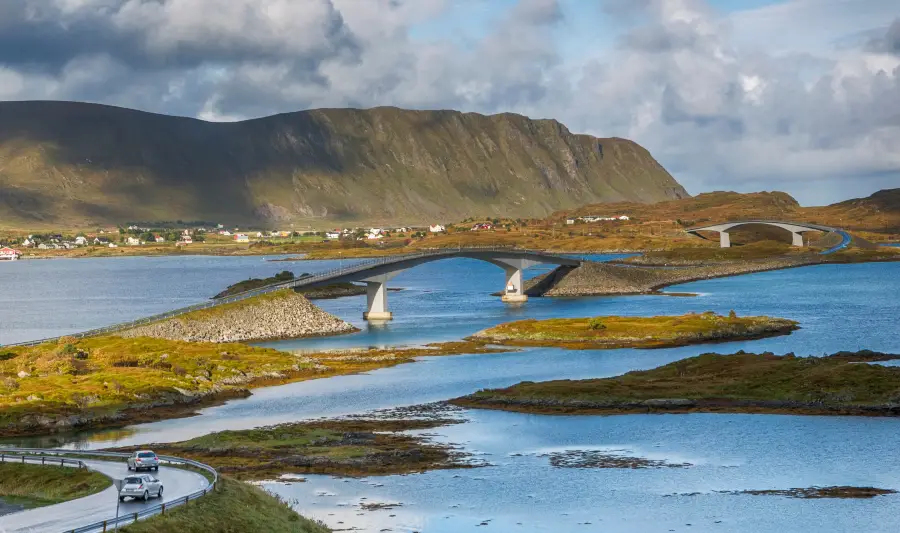
There is essentially nothing to see in the still active fishing village of Fredvang, however the surrounding area is full of excellent hiking, cycling and nature walking opportunities. Some large beautiful white beaches are located just north of the village and are easily reached by car and with easy walks. A couple of trails north and south of the village lead to the famous and scenic Kvalvika Beach. The hike to Kvalvika is medium-easy and takes about 2 hours (one way). Good waterproof hiking boots and rain-resistant clothing are essential.
A path (and a stretch of beach, when it is low tide) leads to the neighboring Vestervika Beach, which is equally scenic and larger. These beaches are a paradise for hikers and backpackers who can camp freely with their own tent. In the summer it is a good way to escape the crowds of the more touristy places of the Lofoten Islands. A steep detour of the path to Kvalvika leads to Mount Ryten (543m), located northwest of the beaches. From here you will have one of the best views of the Lofoten Islands. The hike to Ryten takes about 3 hours (one way) and is quite strenuous.

From Fredvang you could take a nice walk or cycle along the fjord to Selfjord. Another simple hike takes you to Mulstøa headland, north of Fredvang. Experienced hikers may want to conquer the Volandstind peak for great views. It takes about 2.5 hours (one way), the path is of medium difficulty, it is quite steep and starts from a small parking lot along the Fv803 road (GPS: 68.06523, 13.23808).
Ramberg and Flakstad – Flakstadøya Island
Driving along Flakstadøya’s north coast may feel like you’re on a tropical island or some popular beach destination, as the coast features fabulous white beaches overlooking scenic blue-green bays.
Just along the E10 is the Rambergstranda, a large arc of white sand nestled between breathtaking green mountains and the sparkling ocean, with its shades of blue and emerald. If you are lucky enough to be there on a sunny day, don’t miss the chance to take a snap that will surely confuse your friends: are you beyond the Arctic Circle or in the Tropics? Just stick a toe in the water to answer the question.
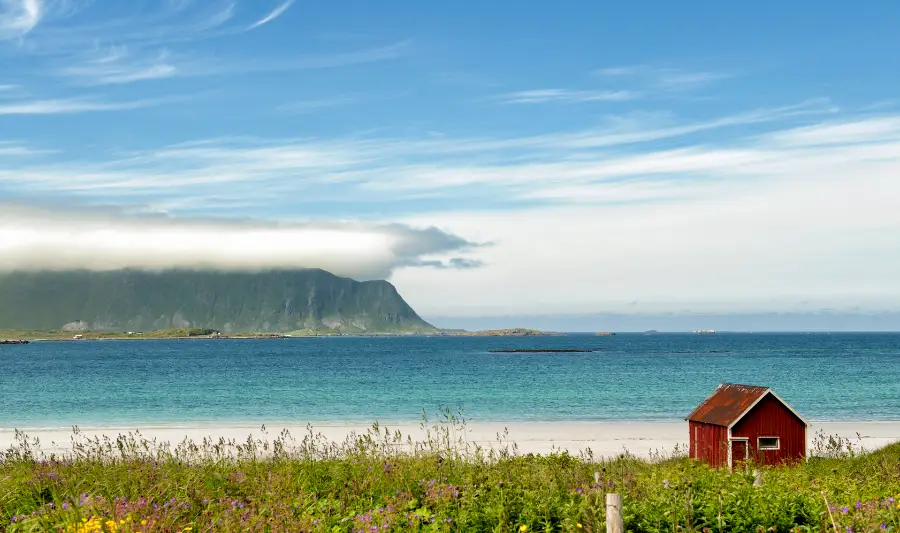
Along the beach there is an iconic lonely little red shed, also visible from the road. It is probably one of the most photographed places in the Lofoten Islands. Definitely Instagrammable! In winter the scenery is almost surreal, with the beach covered in snow.
The flat coast between Ramberg and Flakstad is a popular spot for seeing the midnight sun and is often chosen by backpackers to camp with their own tent. Around Ramberg are some popular hotels and guesthouses, such as Lofoten Cabins Kåkern, Ramberg Gjestegård and Lofoten Beach Camp. There is also a fabulous villa located right on the famous Ramberg Beach, the Exclusive Beach House Rambergstranda.
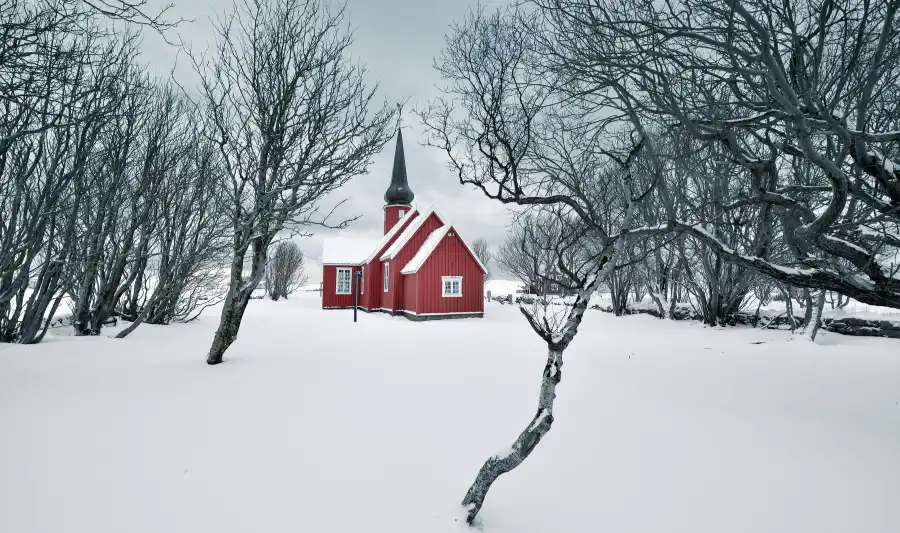
The nearby village of Flakstad, located one step away from the E10, boasts one of the most beautiful churches in the Lofoten Islands, the red-timbered Flakstad Church (Flakstad Kirke) with its distinctive onion dome, dating back to 1780. The church was built of timber from Siberia and also features a chandelier from Russia. The church’s ornate pulpit is a remnant of an older church, dating back to the Middle Ages. The church was also used as a polling station in the 1814 referendum on independence from Denmark, however it is said that due to transport difficulties and inclement weather, the votes came at the National Assembly in Eidsvoll too late to be counted.
Leknes – Vestvågøy Island
Vestvågøy Island is proof that to fully enjoy the Lofoten Islands scenery, atmosphere and charm, you should turn away from the E10 and follow the many back roads. The rocky Vestvågøy Island is characterized by mountains, hundreds of lakes and a few small fishing villages. It serves as a gateway to the more scenic southwestern islands, so many travelers just drive through.
If you are short on time, then you could cross it in 1 hour and easily reach Flakstadøya (to the west) or Austvågøya (to the east), otherwise take the time to explore its beautiful villages, beaches and amazing views. This island is quite large and offers some interesting detours. The E10 runs north of the island, but the quiet and scenic Fv815 could be a viable alternative, running through the breathtaking landscapes of the south coast. If yours is a round trip, you could go with the E10 and come back with the Fv815, or vice versa.




The main town of Vestvågøy is Leknes, which is one of the largest towns in the Lofoten Islands. However, humdrum Leknes is good just for stocking up and grocery shopping, as there are several large, affordable supermarkets to consider if you prefer self-catering. My favorites are REMA 1000, KIWI, Extra Leknes and Bunnpris & Gourmet Leknes.
The small Leknes Airport has frequent connections with Bodø, operated by Widerøe. From Bodø there are flights to and from Oslo and Tromsø. If you opt to get to the Lofoten Islands by air, Leknes could be the starting point of your road trip. There are some good car rentals in Leknes, but it is advisable to book well in advance. You can check rates and availability here or here.
There is also a hotel in Leknes, the Scandic Leknes Lofoten, and there are a couple of good family-friendly accommodations nearby, such as the Lofoten Basecamp and the Rorbu Skreda.
Gravdal and ballstad – Vestvågøy Island
Just 5km south of Leknes is the small village of Gravdal, whose only attraction is the beautiful Buksnes Church, one of the oldest and most beautiful in the Lofoten Islands. Its origins date back to 1324, although it has been damaged and rebuilt several times. The current church dates back to the early 1900s, and is a large rectangular-shaped church, with exteriors in red, white and green, a fine example of the Dragestil style, the dragon style, a popular design in early 20th century Scandinavia.
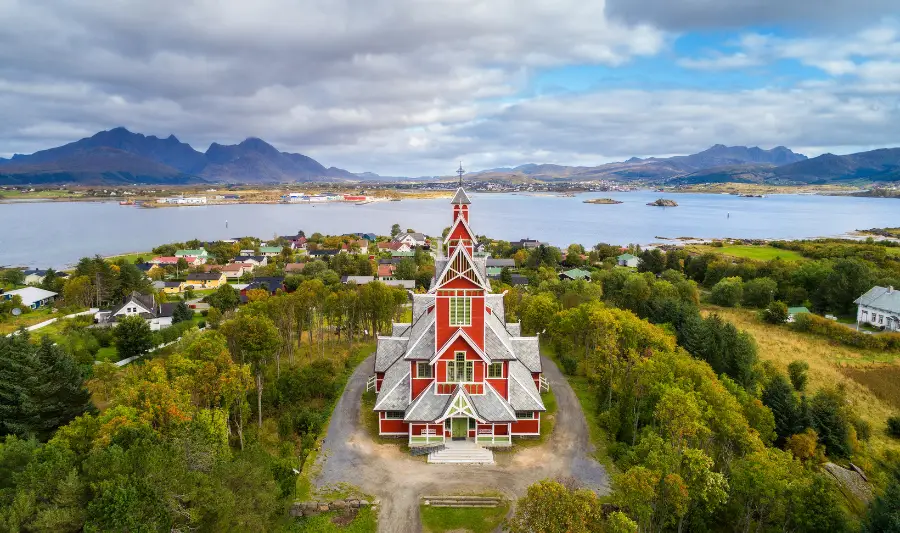
A few kilometers further south you will come across the still active fishing village of Ballstad, home to one of the largest fisheries in the Lofoten Islands. This peaceful village is spread over a series of islets interspersed with ponds and boasts a striking landscape, with two large ports – one for fishing boats and one for leisure boats – dominated by high mountains.
Ballstad is also popular for diving, boasting some of the best accommodations around Leknes, such as the fabulous Hattvika Lodge, Hemmingodden Lodge and Kræmmervika Havn. Also there are some excellent restaurants, such as FANGST Restaurant and HEIM. For a truly unforgettable tasting experience, book the chef’s table at Lofoten Food Studio: Chef Roy Magne Berglund will welcome you into his home with a great tasting menu based on the freshest local seasonal ingredients.
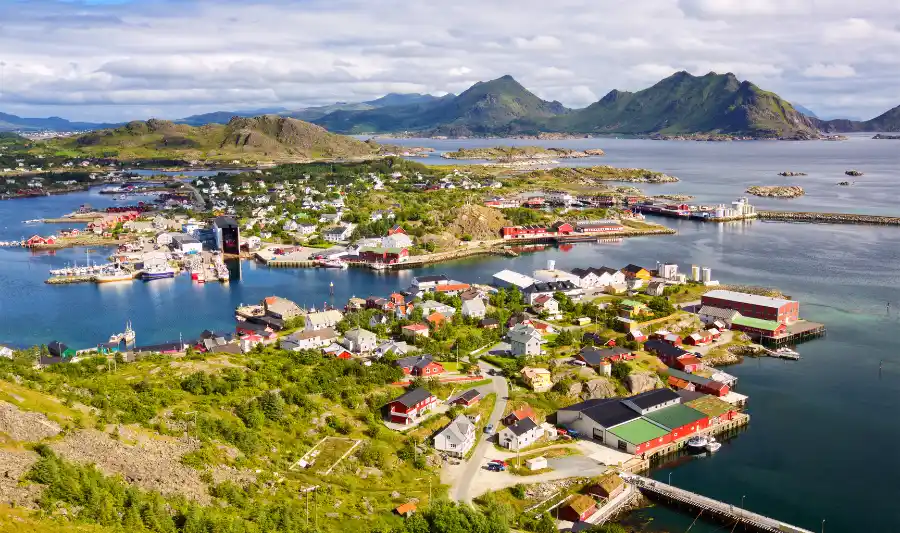
Ballstad is also famous for its fish oil production. Möller’s Tran Cod Liver Oil, Norway’s most famous high-quality fish oil, is produced here. Guests of the Hattvika Lodge will have access to the world’s only Cod Liver Oil Taste Depot, where they can participate in a tasting of the finest fish oil. This is a pillar of local history and culture and is considered an important supplement for the Arctic peoples, as it is rich in Vitamin A and D and Omega-3.
Stamsund, Mortsund and Sennesvik – Vestvågøy Island
The southern coast of Vestvågøy features a few small villages and a small town, Stamsund. Situated along the rugged coastline 10km southeast of Leknes and dominated by Mount Steinetind, the town of Stamsund is famous for being the second port of call for Hurtigruten in the Lofoten Islands.
The town itself has no particular attractions, but if you pass by it will be pleasant to take a short walk around the harbor. Stamsund is in fact one of the largest active fishing villages on the Lofoten Islands, and is located in one of its most important fishing areas. The town has some modest local art galleries, a couple of bars and restaurants and a few theaters.
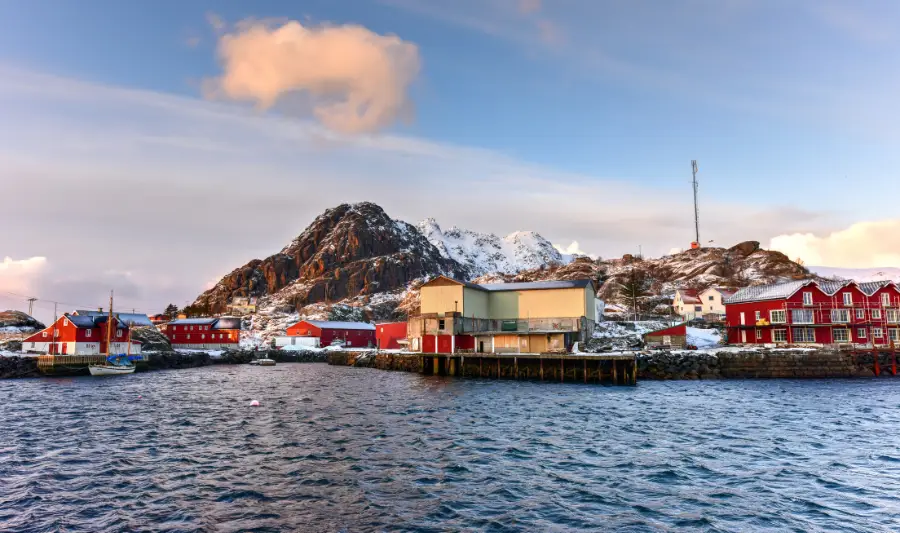
However, you could explore Vestvågøy’s south coast with a detour from Fv815. Just outside the town of Leknes, take the road towards Mortsund. After 5km you will pass the small village of Pettvika, from there continue to Mortsund, another tiny still active fishing village. Here you will see hundreds of fish drying racks, fish warehouses and over 70 wooden fishermen’s lodges, which now house the Statles Rorbu.
The village was founded in the mid-1900s by Ottar Statle, who established his fishing farm and cod liver oil factory here. The village is still managed by the heirs of Ottar Statle, who decided to invest in tourism, building new rorbuer in the 1980s. Since 2007, the Ottars have decided to drop the fishing sales business and stockfish production, so today the village mainly produces cod liver oil of superior quality, which ends up being bottled in Möller’s Tran.
Mortsund’s real draw is its Lofoten Seafood Center which offers an interesting insight into the aquaculture and fishing industry of the Lofoten Islands. It is interesting to see how traditional fisheries have moved on to modern high-tech fish farms, but also how traditional techniques are still the standard for fishing and processing the famous cod and stockfish of the Lofoten Islands. The museum also allows you to visit a nearby active salmon farm and the house of stockfish, a warehouse where stockfish ready for sale are stored and selected. The Lofoten Seafood Center’s restaurant serves excellent specialties based on local salmon and cod.
From Mortsund drive a few kilometers back towards Leknes and turn right to take the scenic Einangen road, which will take you to the opposite coast, towards the quiet village of Sennesvik. Here are a dozen houses scattered in a green valley overlooking a desolate bay. Stop by Skaftnes Gård, an interesting small museum dedicated to local culture, consisting of an old farmhouse, a barn, a pier and a boathouse, scenically located between the ocean and the mountains. Here you can learn more about how the traditional fishermen-farmers lived in the Lofoten Islands until a few decades ago.
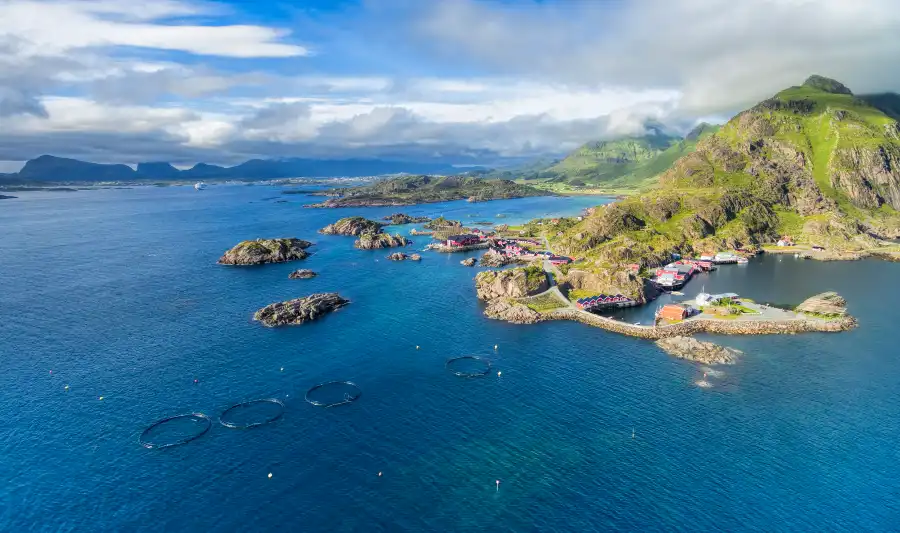
A road will take you north along the fjord until you reach the Fv815 again. Turn right and after a few hundred meters turn right again to Steine. Just after the crossroads there is a small but atmospheric Catholic Church and a Cistercian Monastery where a congregation of 5 monks from Poland lives. On Sundays, mass is celebrated in both Norwegian and Polish. A few hundred meters further, on the right, knitting enthusiasts might take a look at Lofoten Wool Høystålet which sells fabulous hand-knitted sweaters, beanies, mittens, wool socks and locally produced and naturally colored wool, dyed on site. The wool comes from their sheep, of the breed Old Norse Sheep, as well as wool from Spælsau and Norwegian white sheep.
The road skirts scenic coastal landscapes until you reach Stamsund, from where you can continue north until you return to the Fv815 road. From there you can choose to return to Leknes or continue to the northeast of Vestvågøy. This itinerary can also be done in reverse.
Bøstad and Lofotr Viking Museum – Vestvågøy Island
The E10 road from Leknes leads to the scenic north coast of Vestvågøy, passing through a lovely valley interspersed with ponds, country houses and farms. Along the way, between the villages of Bøstad and Borg you can visit one of the most famous attractions of the Lofoten Islands: the Lofotr Viking Museum.
In 1981 a farmer in this area accidentally discovered the ruins of an 83m-long dwelling of a powerful Viking chieftain. Excavations have returned several Viking-era artifacts dating back over 1000 years. A replica of the chieftain’s longhouse has been reconstructed on the site, which now houses an interesting museum on the history and culture of the Vikings.

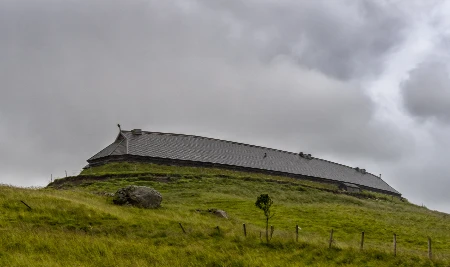
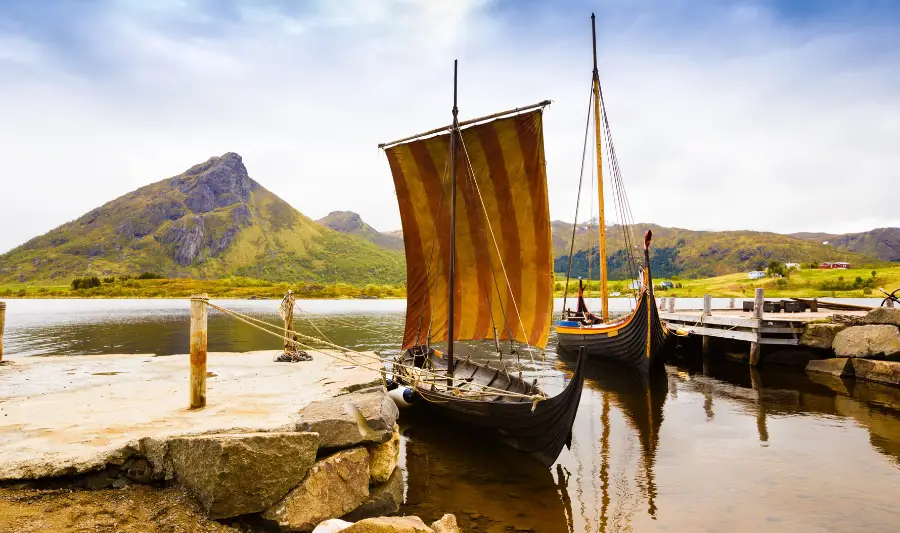
Costumed guides conduct multilingual tours that will allow you to learn more about the Vikings. You will be able to wander through a village featuring several houses, a farm, a smithy and a boathouse. You will also be able to see some replicas of Viking boats and take a day on the Lofotr, which is in fact the replica of the Gokstad Ship, a 9th-century Viking ship found in a burial mound at Gokstad, in southern Norway, and now on display in the Museum of Viking Ships in Oslo.
The museum (tickets from 225 NOK) is a nice thing to do in the Lofoten Islands for families. In early August the Lofotr Viking Museum also hosts a nice Viking Festival, while in summer you can join a Viking Feast (starting at 970 NOK), where you’ll be served Lofoten lamb washed down with a couple of glasses of honey wine or mead. Reservations can be made through the museum or on the official website of the Lofotr Viking Museum.
Gimsøya, Unstad Beach and the North Coast of Vestvågøy Island
The E10 runs along Vestvågøy Island from east to west, but it also allows you to access several nice detours. The south coast is filled with tiny villages, fabulous white beaches and breathtaking views. In addition, there are many hiking and cycling opportunities.
Just north of Leknes is the beautiful Vik Beach and the neighboring Haukland Beach (Hauklandstranda). Climb the nearby Mt. Mannen (400m) for an amazing view. The hike is easy, although not recommended for kids. The path starts from the road to the right of the tunnel, on the opposite side of the beach, and it takes about 1.5 hours to get to the top.
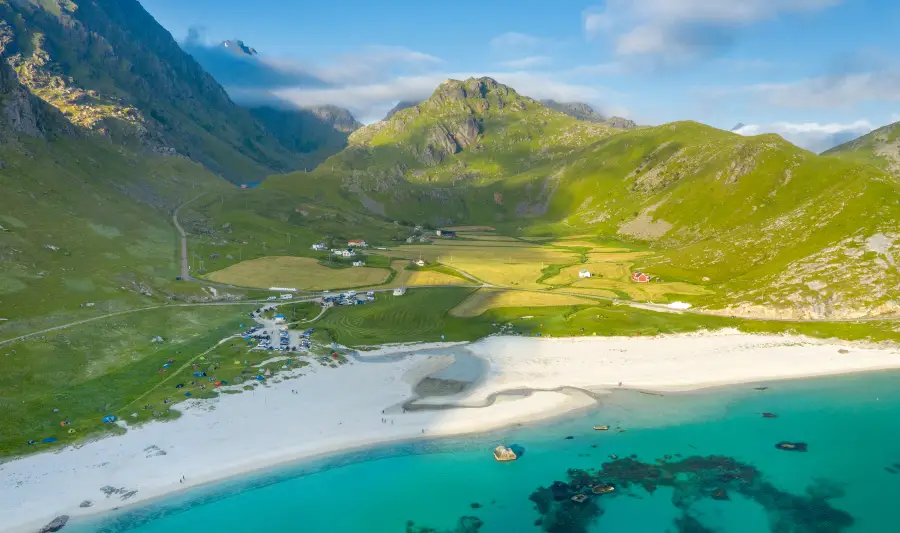
Going through the tunnel you will arrive at the scenic Uttakleiv Beach (Uttakleiv Strand), which has the reputation of being one of the most beautiful beaches in the Lofoten Islands. Fabulous for seeing the midnight sun and Northern Lights, this beach is also one of the most popular camping spots in the Lofoten Islands (for a fee, starting at NOK 250). It is quite touristy, so expect to see a lot of people there.
The most popular detour is to Unstad, which starts at an intersection near Borg. The road is about 10 km long, runs through a beautiful valley and runs alongside a couple of fjords before arriving at what is one of the most famous beaches on the Lofoten Islands, Unstad Beach (Unstadstranden), which is hugely popular with surfers. This is also a popular camping spot. There is a charge for parking and camping near the beach (camping in your tent from NOK 200, parking only from NOK 50). Get used to the bizarre local custom: there is no one to collect the payment, instead you will have to pay by bank transfer to an IBAN indicated on the spot. It is quite common in the privately owned car parks and campsites of the Lofoten Islands.
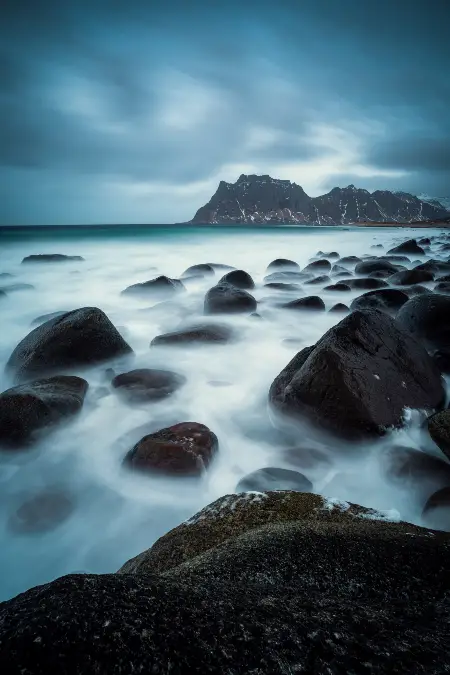
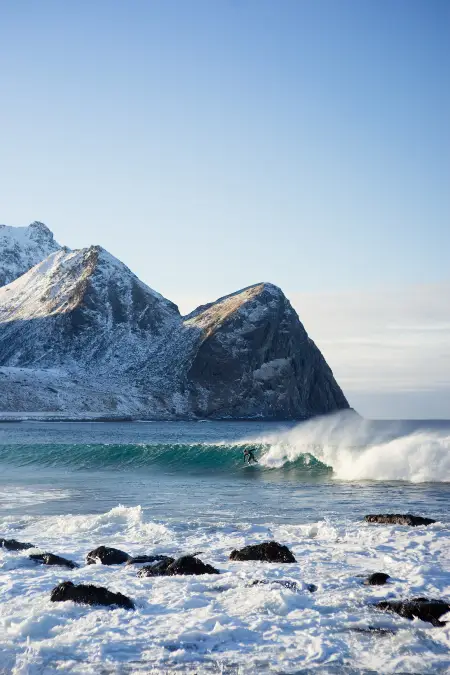
Along the way, make a stop at Lofoten Gårdsysteri, the best organic farm in the Lofoten Islands. Set in an idyllic landscape, between green grasslands and a peaceful fjord, this family-run farm produces and sells excellent hand-made cheeses and sausages. Try their excellent Steinfjording, pure aged goat cheese, Vinterlys, solid blue cheese produced on fresh goat milk, and Ferskost, fresh cheese flavored with honey or locally produced herbs. The hand-made sausages from freely grazing goats and pigs are also noteworthy. Lofoten Gårdsysteri’s café also serves good homemade cakes, try the one made with rhubarb from the farm. In the summer you will be able to see goats, chickens and pigs grazing freely around the farm.
You could pick up what you need for a nice picnic here, the area around Unstad Beach offers several good places for a break, perfect for enjoying the midnight sun. My secret spot is the little shelter located a few minutes’ walk from the parking lot north of Unstad Beach (GPS: 68.27788, 13.57908). Don’t blurt it out!
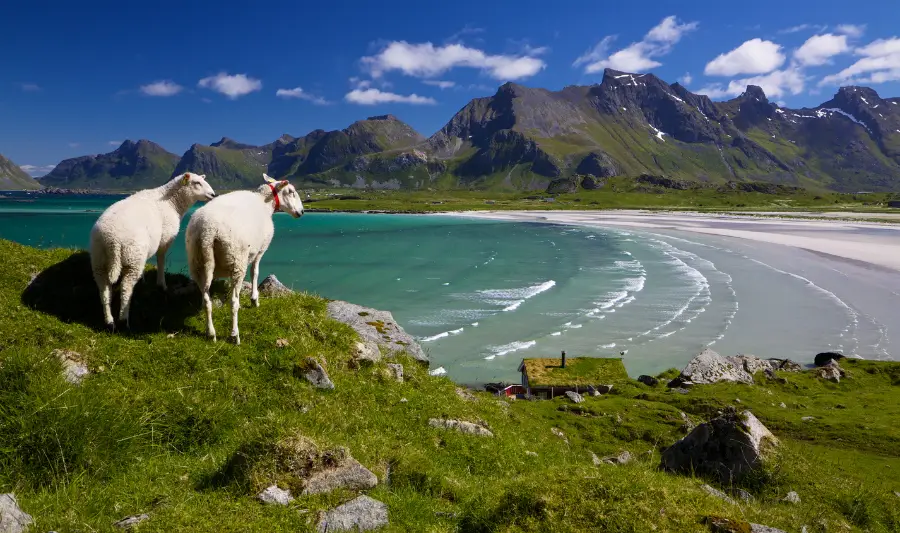
Another great spot for camping and picnics is Eggum, easily accessible by car with a detour from Bøstad or an easy 5-kilometer hike from Unstad Beach. Here, too, are some scenic beaches and places to camp or picnic. There are also the remains of an old tower which housed a German radar during WWII. Here, too, parking and camping are subject to charges. There are a couple of great places to stay in the area, such as Unstad Arctic Surf and Lofoten Links Lodges. Budget travelers are sure to appreciate the cozy rooms, apartments and beds in mixed or female-only dorms at FURU Hostel & Café.
The area northeast of Bøstad is covered with grasslands and tiny villages overlooking a rugged coastline, small ports, lakes and mountains. You could easily skip it and head to the small island of Gimsøya, connected to Vestvågøy by road bridge. This island is mostly flat, with wide prairies interspersed with ponds, farms and a quiet and not very touristy coast. The island is a popular place for cycling and horse riding and there is even a golf course. These activities are organized by Lofoten Links Lodges, which also boasts beautiful accommodation in apartments and villas with views.
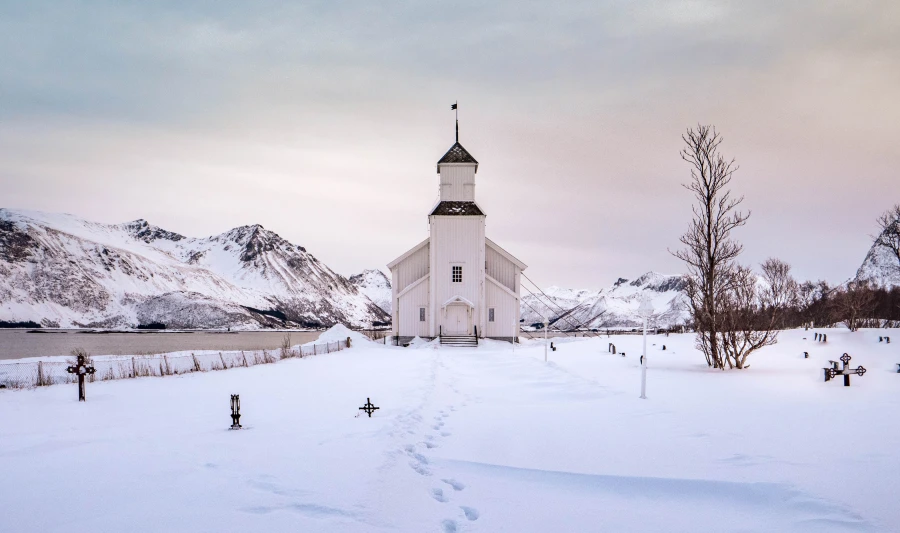
The Fv862 goes around the island of Gimsøya, along it joins the Fv861 which will take you back to the E10. After the village of Saupstad take a short detour to Gimsøysand to see the picturesque and lonely Gimsøy Church (Gimsøy Kirke), dating from 1876. The church is fixed to the soil by solid ropes, in order to prevent it from falling apart because of the wind. The large beach (called Vinjestranda) in front of Saupstad’s gas station café is a good place to camp with your tent. Beware of strong winds! From Saupstad in a few minutes’ drive you will reach the Gimsoystraumen Bridge which connects Gimsøya to Austvågøy.
Værøy
The wonderful Værøy is one of the most remote islands of the Lofoten Archipelago. Narrated by Edgar Allan Poe in one of his novels, Værøy is located 35km south of Moskenes, accessible only by ferry or helicopter. It takes over an hour by ferry to get to Værøy from Moskenes and around 5 hours from Bodø, but the connections are not regular and frequent, so you will need to plan your trip to Værøy carefully, otherwise this can leave you stranded here for 2-3 days.
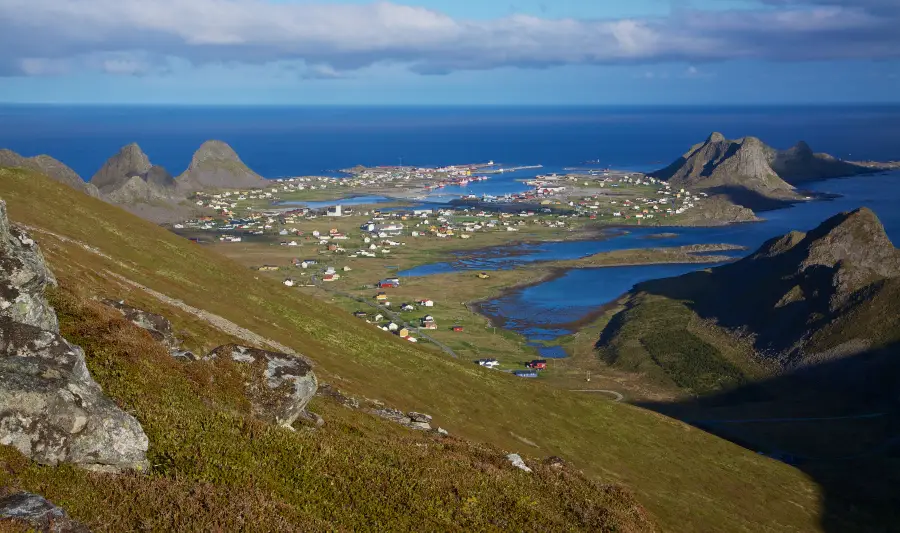
Værøy is an island just 8 km long, covered by grasslands and steep and rugged mountains, which dominate its entire central and southern part. Along the coast the mountains slope gently towards the sea, giving way to a virtually endless series of deserted and desolate stony beaches. Its approximately 700 inhabitants live mainly in the various houses scattered along the flat plain located in the northwest of the island, where the villages of Sørland and Røssnesvåg are located.
A road, the Fv791, runs along the northern coast connecting several houses scattered here and there, up to the old Værøy Airport, no longer operational. The airport was very dangerous due to strong winds and extreme weather conditions. The airport has been closed since April 12, 1990, when a fatal accident caused by strong winds took place. Since the early 1990s, only helicopters have landed in Værøy, in a small heliport located on the opposite side of the island, in the village of Røssnesvåg.
Værøy is a popular hiking and bird-watching destination: here is one of the largest and most important puffin colonies in Norway! The bird colony is located on the southwestern cliffs of Mount Måstadfjell (435m) and is home to over a million puffins, eiders and gulls that breed in the summer months, as well as sea eagles, kittiwakes, guillemots and cormorants. The hike on Måstadfjell can be strenuous and dangerous, as it can be very steep and slippery, so the best way to spot birds is to take a boat trip. You can book it on the spot by asking your host. There are only a few guesthouses in Værøy, the most popular being Bensvik Brygge.

Among the most interesting hikes is the one to the ghost town Måstad, easily reachable with a path that starts near the old airport (GPS: 67.68276, 12.65248), passes through Eidet beach and ends in Måstad. This old village was abandoned at the end of WWII and is now a wilderness lover’s paradise. You will be able to camp freely with your tent and enjoy the peace and beauty of the place. The hike is easy and takes about 3-4 hours (one way). Good waterproof hiking boots and good waterproof and windproof clothing are essential.
The climate of Værøy is unusually mild: you will hardly see the island covered by a thick blanket of snow and the average temperatures remain slightly above freezing all year round. This is due to strong winds – powerful storms and gusts of wind whip the island all year round, so be prepared. Another popular hike is to the scenic Håen viewpoint, easily accessible via a trail that starts just northwest of the town (GPS: 67.67306, 12.65615) and takes you to the old military radar base in about 2 hours. The view is amazing and along the way you can see the old eagle traps that the locals used to hunt.

Værøy is also home to the oldest church in the Lofoten Islands, the onion-domed Værøy Gamle Kirke, dating from the late 18th century and built on the site of an older church, dating from the 11th century. This small red-timber church is located near the old airport, along the road, and inside it retains a fabulous 15th century alabaster altarpiece. It is not easy to find it open, in case you ask your host or the tourist office, located in front of the town hall.
Getting to Værøy
The most frequent connections are to and from Bodø. There are daily car ferries from Bodø to Værøy (3.5 – 5 hours, adults from NOK 200, car and driver from NOK 698, one way). The timetables must be checked online and verified on the spot, at the ferry terminal, as they change frequently and suddenly. In summer, ferries are more frequent than in winter. There are also some ferries to and from Moskenes (1.5 hours, adults from NOK 200, car and driver from NOK 592, one way) but only a few days a week.
If you want to visit Værøy and enjoy its most popular hikes and maybe the puffin-spotting boat tour (summer only), plan to stay in Værøy at least 2-3 days. An alternative are the helicopters to and from Bodø operated by Lufttransport (0,5 h). There are 1-2 helicopters per day, and the fare starts at NOK 1197. Tickets can be booked online on their website.
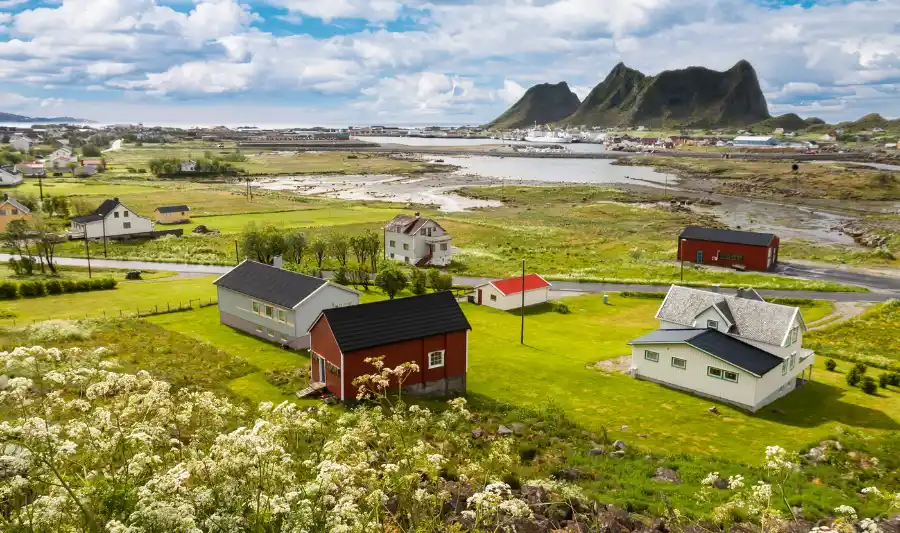
Røst
The small, flat island of Røst is the most remote and southerly on the Lofoten Islands, and probably the least visited. With just 500 inhabitants, the island is essentially a large fishing village centered around Røstlandet. During the fishing season there may be over 600 fishing boats around Røst, as the island is famous for its stockfish, which is reputed to be the best of the Lofoten Islands.
Røst is also lashed by winds and boasts average temperatures above freezing all year round, a perfect climate for drying fish. The island is covered with large grasslands interspersed with ponds and thousands of traditional fish drying racks. Going there in the spring could be very impressive, as the racks – called hjells – are full of fish.
The island is very easy to get around by bike or on foot, as it is mostly flat. There are a couple of small churches, the Røst Church located in the heart of Røstlandet, a stone’s throw from the town hall, and some old churches located near the airport, including some ruins dating back to the Middle Ages and Viking times.

The coasts are mostly covered with marshes and peat bogs. Here in 1432 the Venetian sea captain Pietro Querini landed, saved by the islanders after a shipwreck off Røst. Querini was the first and only one to write a diary that tells how the islanders lived in the Middle Ages. He was delighted by their harmonious and simple society, and he really appreciate the local cod. And it is perhaps for this reason that stockfish, once brought to Venice, became one of the most renowned specialties of Venetian cuisine. Even today, most of the stockfish produced in the Lofoten Islands goes to Italy.
Røst is a bird watcher’s paradise, as it is home to one of the most important seabird colonies in the world and one of the largest bird cliffs in the North Atlantic, with puffin colonies, as well as colonies of shag, kittiwake, and cormorants. Seabirds are mostly found on the islands south of Røst, in the area called Røstøyan, and on the island of Nykan. These are deserted islands that can only be visited on a boat tour from Røst. Tours typically also allow you to see the scenic, lonely Skomvær Lighthouse, located on a rocky islet, the southernmost of the Lofoten Islands. Tours, as well as bike and fishing equipment rentals, are available at the few family-run hotels on the island: Røst Bryggehotell and Kaikanten Rorbuer Røst.
Getting to Røst
The car ferries between Bodø and Værøy make a short stop in Røst and dock on the island’s southwest corner, 3 km from Røstlandet but only a few hundred meters from the island’s two main accommodations. Ferries from Moskenes to Bodø via Værøy also stop at Røst. Timetables can be checked online. Fares are essentially the same as for Værøy.
The small Røst Airport has flights to and from Bodø (25 min, starting from 1200 NOK) and Svolvær (30 min, starting from 700 NOK), operated by Widerøe.
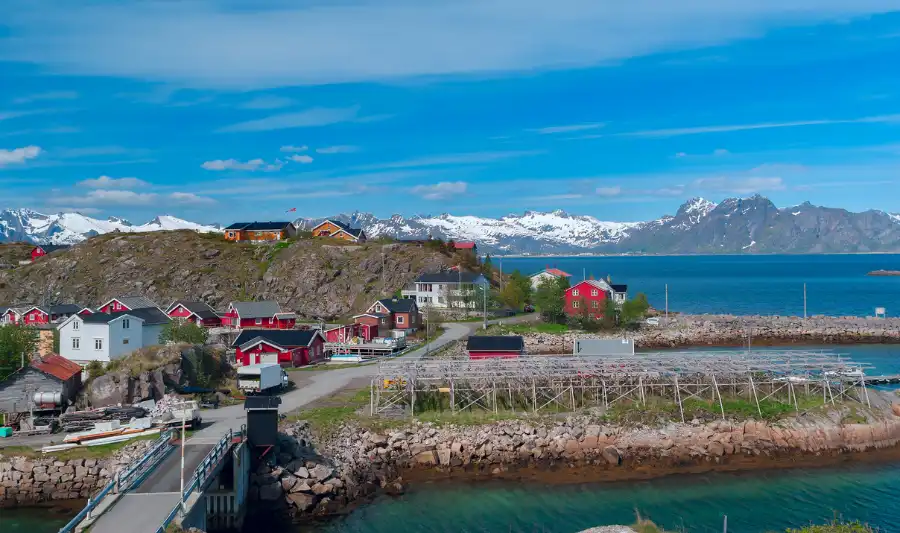
Skrova
Skrova Island and nearby uninhabited Litlmolla Island are among the least known and traveled in the Lofoten Islands, yet are easily accessible from Svolvær. Boat tours from Svolvær make it easy to visit both islands, but there are also frequent public ferries running back and forth between Svolvær and Skrova (around 30 min – express ferries around 15 min, starting at NOK 108 one way). Here you can find the timetables of ferries and express ferries.
Skrova boasts several fabulous beaches and is full of easy hiking and nature walking opportunities. Do not miss the view of the scenic beaches and coves located along its northern coast, easy paths will allow you to climb the Skrovafjellet Hill in less than an hour from the port. The small village, which was once one of the largest fishing villages in the Lofoten Islands, is draped around the harbor. It has no particular attractions, but you can still enjoy its pleasant relaxed atmosphere.
Lofoten Islands Best Tours and Activities
Lofoten Islands are full of things to do and see, but if you want to make the most of your trip then you should check out what are the most popular activities and tours.
TROLLFJORD BOAT TOUR (APPROX. 3.5 HOURS)
One of the must-do on the Lofoten Islands is the boat trip to the Trollfijord, the scenic fjord located in the most remote corner of Austvågsøya Island. Accessible only by boat, this breathtaking fjord is popular for its stunning scenery and seabirds, such as sea eagles.
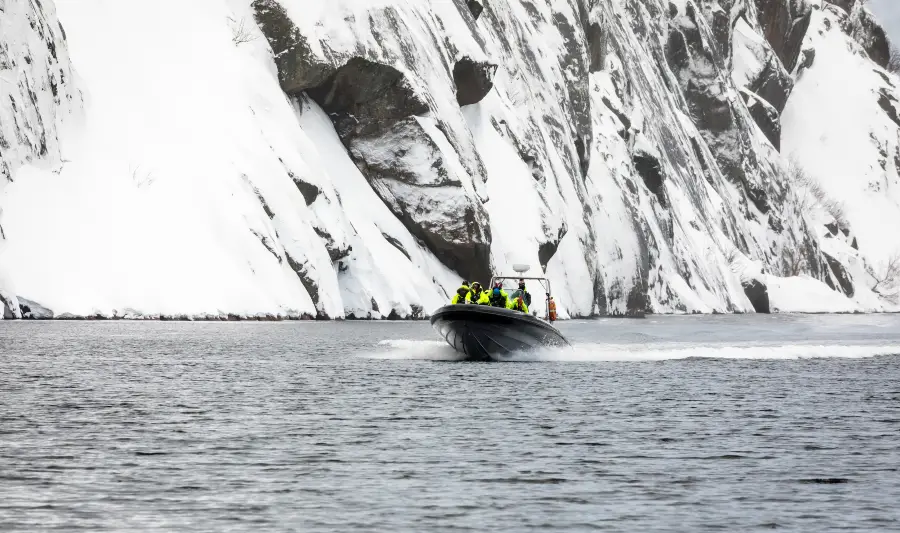
REINEFJORDEN CRUISE (APPROX.1.5 HOURS)
Another unmissable thing to do in the Lofoten Islands is the sightseeing cruise on the Reinefjorden, the great and sublime fjord that surrounds the most scenic corner of the Lofoten Islands: the villages of Reine and Hamnøy. This boat trip will allow you to explore the fabulous surrounding fjords, including Kjerkfjorden and Bunesfjorden, and visit some of the most remote villages of the Lofoten Islands, such as Rostad, Vindstad and Forsfjorden, which can only be reached by boat.
You could also get off at Vindstad and continue on your own with the hike to Bunes Beach. In that case, you can return on one of later departures, with the same ticket.
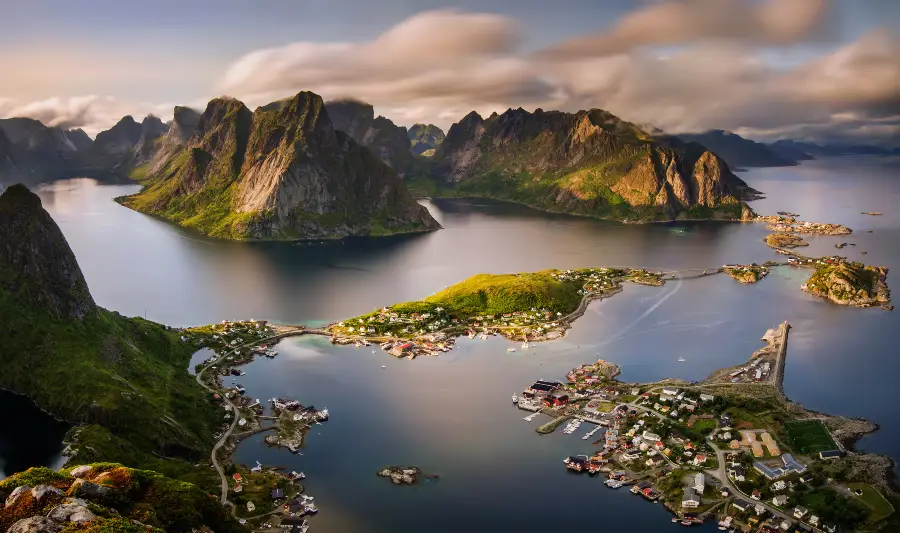
LOFOTEN’S TRADITIONAL FISHING TRIP (APPROX. 4 HOURS)
If you like fishing, you can’t miss this boat tour! You will be able to set sail aboard an old traditional fishing boat and enjoy an authentic fishing experience in the Lofoten Islands. Depending on the season, you can fish coastal cod, skrei, coalfish, haddock, mackerel and much more.
Equipment is provided, as well as help and priceless advice from local expert fishermen. After having caught your fares, you’ll learn how to fillet the fish on board and feel free to take your catch home with you, if you wish. No fishing experience is required, as the tour is also suitable for beginners.
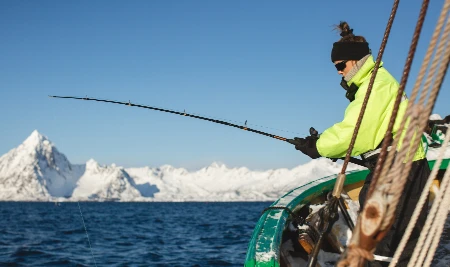
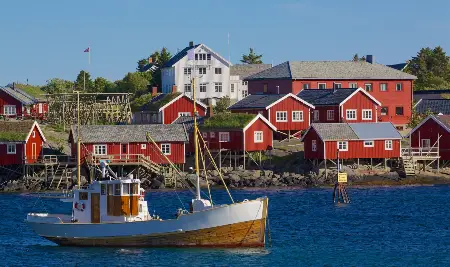
Lofoten Islands Northern Lights
Is it possible to see the Northern Lights on the Lofoten Islands? The short answer is yes, but the chances are not as high as in Tromsø, Abisko or other locations in Lapland. The Lofoten Islands are perfectly located in the Auroral Oval, which is the area where the probability of seeing an Aurora Borealis is quite high.
Not all regions of Norway are good for seeing the Northern Lights, but the Lofoten Islands are located about 200 km north of the Arctic Circle, making them a good area to see them. So, we are at the right latitude and within the Arctic Circle. What’s wrong?
The fact is that in the Lofoten Islands, being located right on the ocean, it can often be cloudy. And the best way to see the Northern Lights is with a clear sky. This is why in the inland or far north areas you have a better chance: there you will have a higher chance of clear skies.
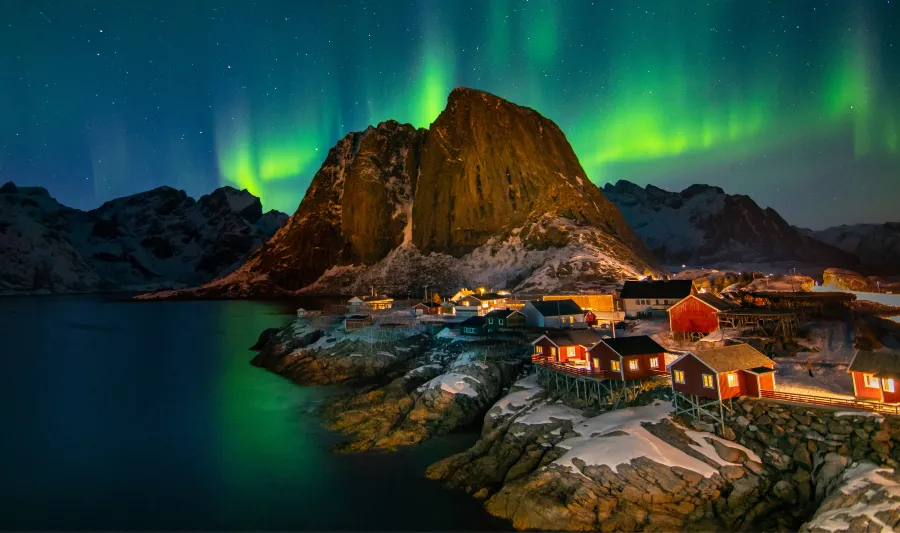
Despite the rainy climate of the Lofoten Islands, if you are lucky you may see some mind-blowing Northern Lights. You’ll just have to hope it’s not too cloudy. January and February are usually good months, but it is difficult to predict. Sometimes it happened to see the best Northern Lights even in March, late August or September.
The general rule is that if it’s dark enough and it’s a cloudless night, you’ll be able to see the Northern Lights in the Lofoten Islands from late August to mid-April. You will not be able to see them from May to early August, due to the Midnight Sun.
You will be able to see the Northern Lights in the Lofoten Islands right from your accommodation, preferably in a small village, so as to have less light pollution. Some popular places to spot the Northern Lights are beaches, such as Uttakleiv Beach or Haukland Beach. There are also some tours led by expert local guides, which will allow you to spot the best Northern Lights, taking you to the best spots (which could change from night to night, depending on the forecast).
Lofoten Islands Beaches & Hikes
Haukland Beach and Uttakleiv Beach
At the top of the list of the best beaches in the Lofoten Islands is Haukland Beach, defined as the Best Beach in Europe by Lonely Planet. You may not believe it: to see the most beautiful beach you will have to go above the Arctic Circle. And indeed, Haukland Beach will amaze you with its pure white sand and crystal clear ocean views, with shades of emerald, turquoise and deep blue.
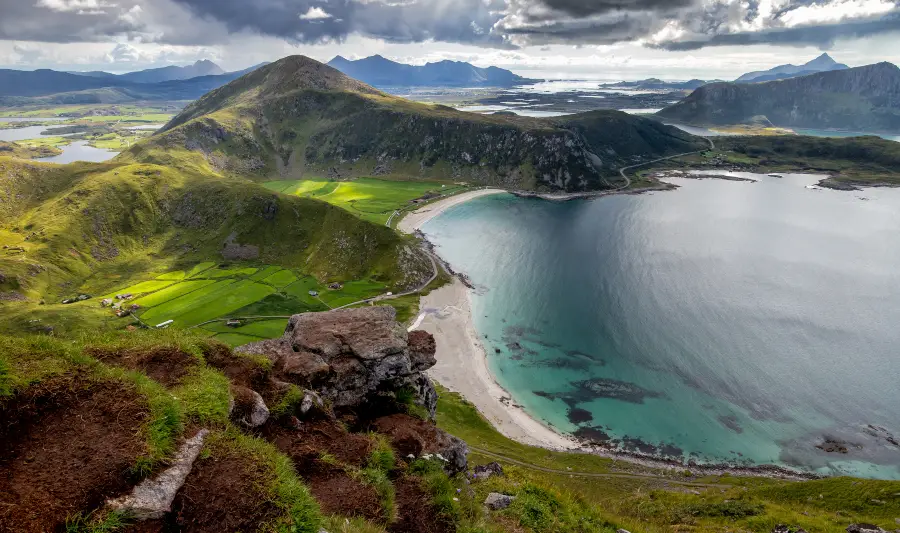
Set in a landscape of incredible beauty and surrounded by high green mountains, Haukland Beach is one of the most popular attractions of the Lofoten Islands, as is the neighboring Uttakleiv Beach, famous for its scenic smooth pebbles. Be warned that the latter is a hugely popular camping spot, and it can get crowded in the summer.
Uttakleiv Beach is very beautiful at sunset and its scenic natural pools (on the left side of the beach) are very popular with photographers. In winter it is an impressive place to see the Northern Lights. Both beaches have car parks that are also accessible to RVs. You can also camp overnight. The parking lots, as well as the campsite, are subject to charges. The same goes for those who camp in their own tent.
Hike to Moskenesøya Beaches: Kvalvika Beach, Bunes Beach and Horseid beach
Those to the scenic hidden beaches of Moskenesøya Island are undoubtedly among the most beautiful hikes in the Lofoten Islands. You will enjoy breathtaking landscapes, unspoiled nature and peace and silence. Can you ask for more?
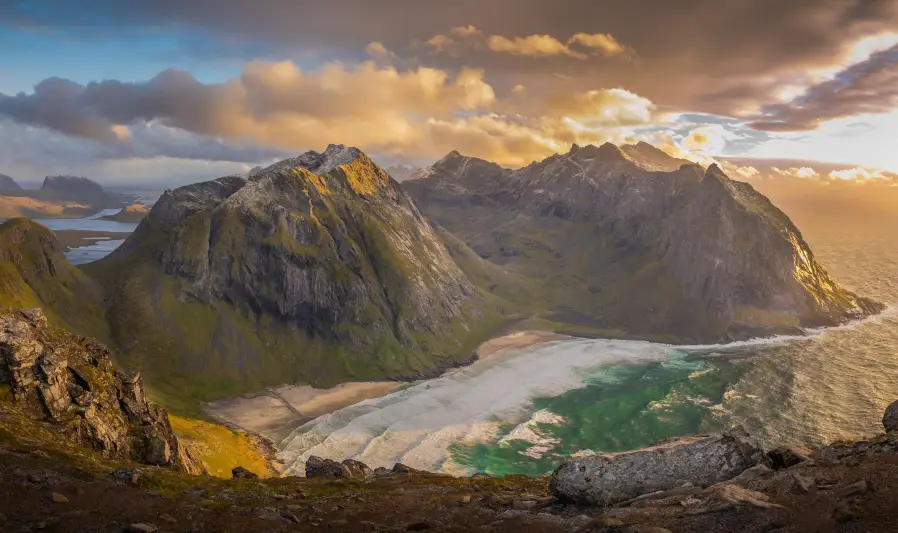
Most tourists don’t venture into Moskenesøya’s wilderness, so hikers will benefit from the tranquility of these beautiful places, high mountains and valleys that look like something out of a Tolkien’s novel. The most popular is Kvalvika Beach, located along the northwestern coast of the island and surrounded by steep mountains. From Kvalvika a small path along the cliff allows you to easily reach the neighboring Vestervika Beach.
You can get there with a path that starts from the village of Fredvang. The trailhead is located along the road south of the village (GPS: 68.06874, 13.13313). From here you just have to follow a muddy and rocky path approximately 2 km long and with a vertical drop of 170 meters, which will take you to the beach in about 2 hours.
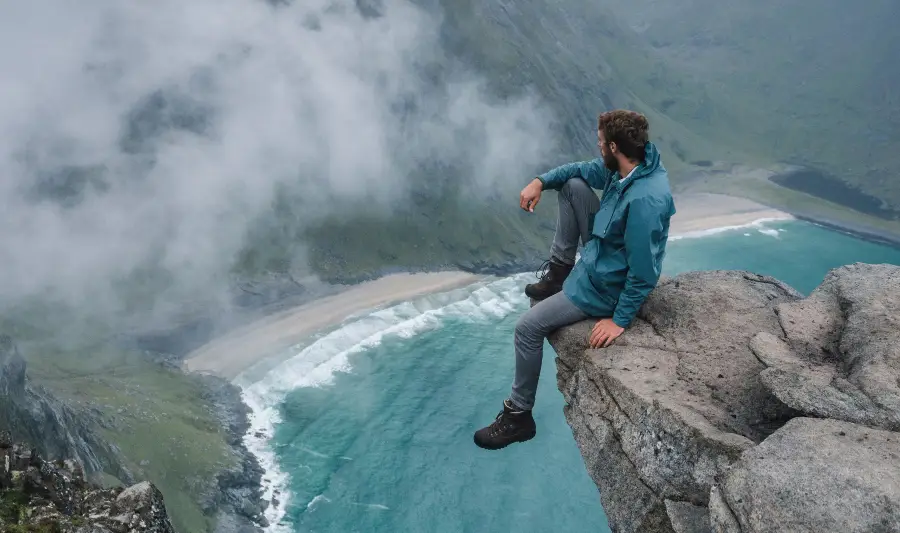
A great alternative could be the trail that starts from the fabulous green valley just west of Fredvang (GPS: 68.08563, 13.14382). This trail is slightly longer, but the views are amazing and it is well situated for climbing up to Mount Ryten (543m) from which you will have the best view of Kvalvika Beach and the surrounding landscape. Near the trailhead there is a large parking lot, also suitable for RVs (for a fee, 100 NOK).
Another exciting hike is to Bunes Beach, a huge 700-meter-long beach, located at the mouth of an impressive glacial valley, squeezed between high mountains – including the imposing granite slab of Helvetestinden (600m) – and a narrow fjord. The surrounding mountains make the beach virtually inaccessible from the south, even for experienced hikers, except via the Vindstad Fjord.
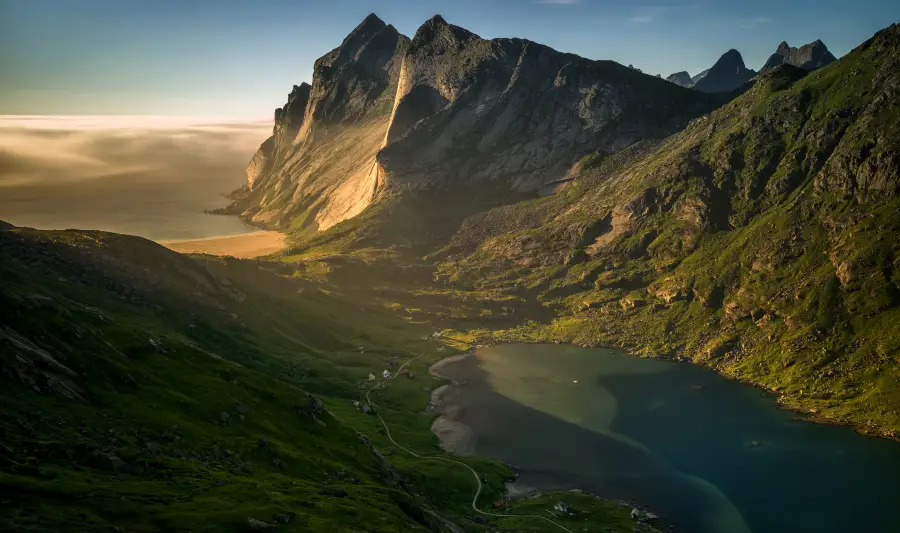
To reach Bunes Beach you can take the ferry from Reine to Vindstad. The ferry leaves right in the heart of Reine, behind the Circle K Reine gas station. The ferry (80 NOK one way) takes about 30 minutes to get to Vindstad cruising the calm waters of the Reinefjorden, in a mind-blowing setting. This is a small passenger boat, which goes on first come basis. In summer, arrive at the pier early. Ferry runs infrequently, but in summer there may be extra runs, inquire at the dock in Reine. You can find the timetables here, select “Nordre Nordland” and then “Reinefjorden – Rute 18-773”.
Vindstad is a tiny and remote village, accessible only by boat and set in an idyllic landscape. In the summer, the old village school houses a small, modest café. Continue along the path that runs along the fjord and goes up the ridge, on the other side there is the Bunes Beach! It is an easy walk (about 3km, 1 hour one way) and is also suitable for families, and is also a popular wilderness camping spot. So, bring your own tent if you want!
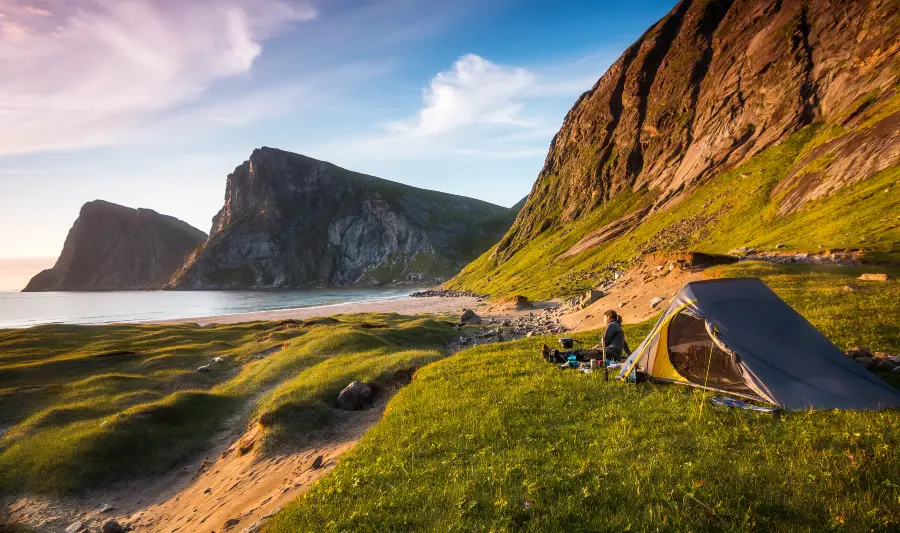
Another very beautiful beach is Horseid Beach, located a few kilometers north of Bunes Beach. To get there you will have to take the same ferry that takes you to Vindstad, but get off at the previous stop, in the tiny village of Kirkefjord, at the bottom of the Reinefjorden, a handful of houses nestled between the emerald waters of the fjord and steep mountains, accessible only by boat. From here a little marked path runs along the gully until it reaches the large, white Horseid Beach. The hike takes about 2 hours (one way), the path is rocky and muddy, sometimes quite steep, but quite easy. It is one of the less touristy places on the Lofoten Islands, and is perfect for camping in the wilderness.
For these hikes you will need good waterproof hiking boots, enough food and water, a good waterproof windbreaker. Wind can be strong and thunderstorms are frequent, making the ground very muddy. Bring everything you need to stay in the wilderness safely. If you bring electronic devices, such as a camera or smartphone, bring a waterproof case.
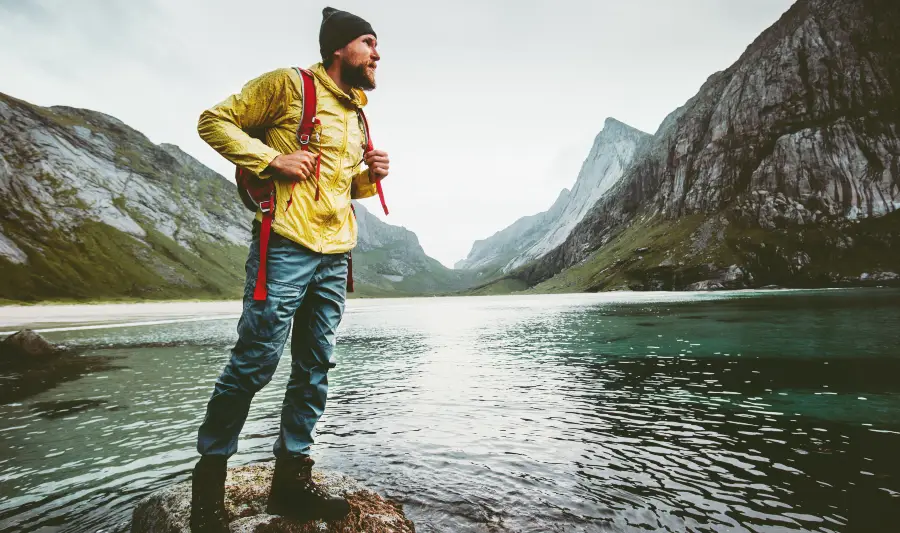
Ramberg Beach, Skagsanden Beach and Flakstad Beach
The most popular beach of the Lofoten Islands is arguably Ramberg Beach, located right along the E10, near the village of Ramberg, on Flakstadøya Island. Famous for its scenic white sand arc, stunning turquoise ocean waters, and lonely red wooden shed, Ramberg Beach is a must-see photo spot, even if you’re not a photographer!
Just to the northeast, around the tiny village of Flakstad, are a couple of other popular beaches, the large Skagsanden Beach and the neighboring Flakstad Beach, both famous for their relaxed atmosphere, beautiful ocean color and wide expanse of sand that invites long pleasant walks and picnics by the sea.
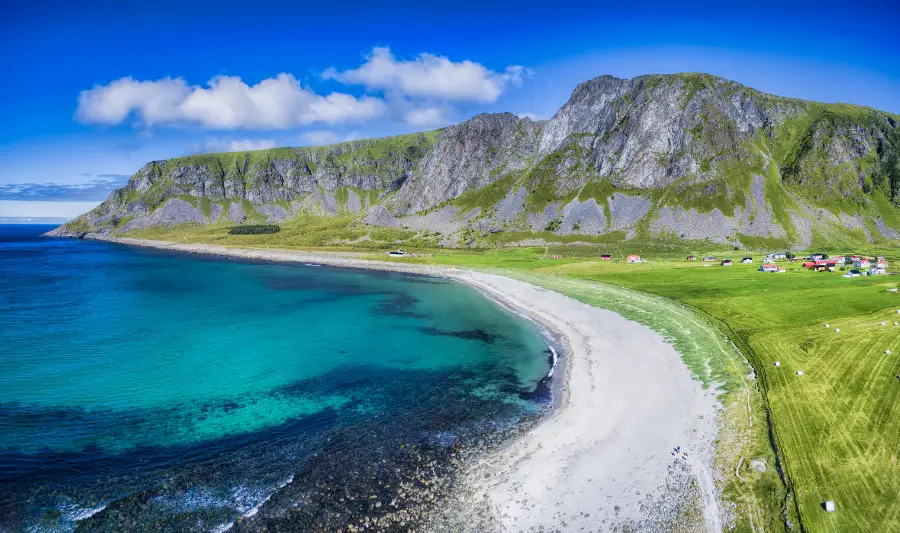
Unstad Beach
Another very popular beach on the Lofoten Islands is Unstad Beach, located on the north coast of Vestvågøy Island. Nestled between green grasslands and mountains, this beautiful white beach attracts surfers from all over the world. The average ocean temperature here remains mostly above 15 °C and the winds and foaming waves of the ocean make it one (if not the only) of the best surf destinations in the Arctic.
Whether you’re an expert or a beginner, you might want to stay at the Unstad Artic Surf, which boasts some of the best accommodations in the area, a surf school and equipment rental, as well as free bike rentals.
How to Sleep in a Traditional Rorbu (a Must-do!)
One of the must-do on a trip to the Lofoten Islands is to stay in a rorbu, the traditional wooden fisherman’s house. These iconic little houses are one of the main attractions, and represent an important element in the local history and culture. The rorbu (plural: rorbuer) was generally a collective accommodation for fishermen.
The Lofoten Islands until the mid-1900s were a remote area, mainly characterized by fishing villages. Each fishing village belonged to a fishery. The fisheries were owned by businessmen and merchants: they were the owners of all the rorbuer in the village, as well as the shops, bakeries, the post office and telegraph office, the hydroelectric power stations and so on.
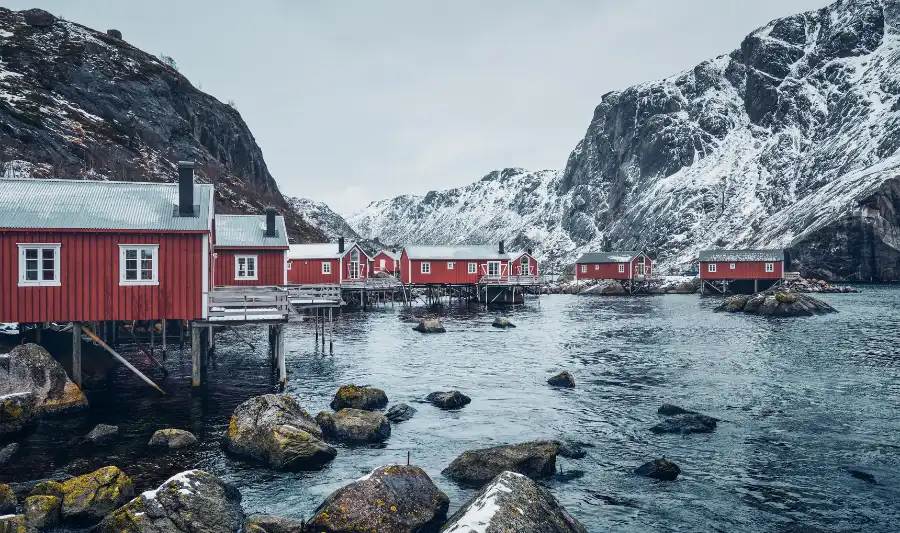
Each fishing village had a port, warehouses, boat houses and repairs, here the fishing boats docked before and after the fishing trips. In addition, there were artisan workshops and often also some factories, such as those that used fish by-products, for example the renowned fish oil factories.
The village also had a chieftain, who usually lived in a luxurious and elegant mansion, easily recognizable from the basic and poor rorbuer. During the main fishing season, each village welcomed hundreds of fishermen. They rented a bed in a rorbu from the chieftain, paying for it in fish, that is, with their own work. The fishermen were paid by the piece, so the sum of the rent was deducted from the salary. In each rorbu lived dozens of fishermen huddled close to each other. It was basic and not so comfortable accommodation. But not all fishermen were so lucky, the poorest slept on boats or in warehouses.
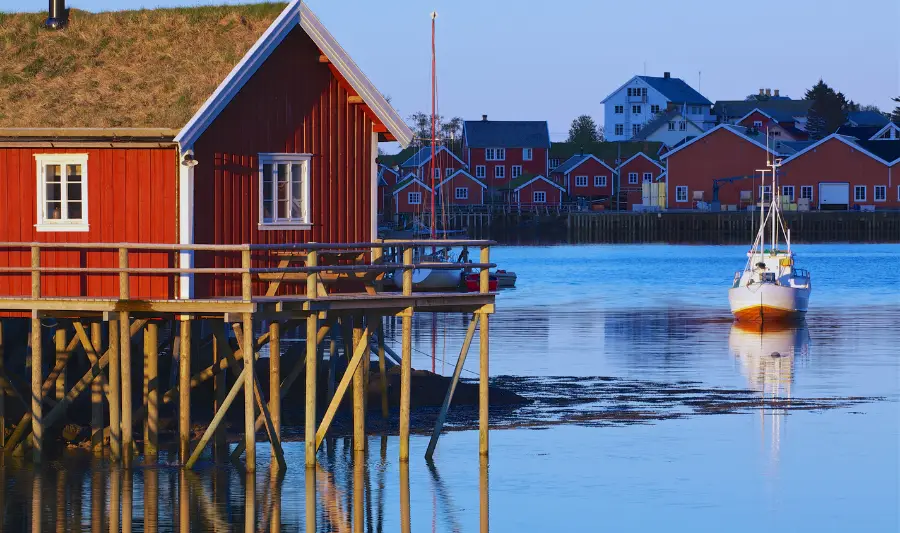
In recent years, fisheries have modernized, as have fishermen. Most of the old rorbuer have been finely restored and have become luxurious and comfortable accommodation for tourists. Staying in a rorbu in the Lofoten Islands means experiencing a piece of local history. These are the best and most authentic accommodations you will find in fishing villages, so be sure to book at least a few nights in one of them.
But be warned, the best rorbuers and especially those from the most popular villages, such as Å, Reine and Nusfjord are in high demand, so booking well in advance is recommended!
These are some of the best authentic rorbuers you could stay at in the Lofoten Islands:
- Eliassen Rorbuer (Reine)
- Reine Rorbuer (Reine)
- Rostad Retro Rorbuer (Reine)
- Valen Cabins in Reine (Reine)
- Nusfjord Arctic Resort (Nusfjord)
- Lofoten Cottages (Nusfjord)
- Solsiden Brygge Rorbuer (Ballstad)
- Hattvika Lodge (Ballstad)
- Salteriet (Å)
- Å Rorbuer (Å)
- Å-Hamna Rorbuer (Å)
- Lofoten Cabins Kåkern (Ramberg)
- Anker Brygge (Svolvær)
- Svinøya Rorbuer (Svolvær)
- Nyvågar Rorbuhotell (Kabelvåg)
- Henningsvær Rorbuer (Henningsvær)
- Lofoten Cabins Tind (Tind)
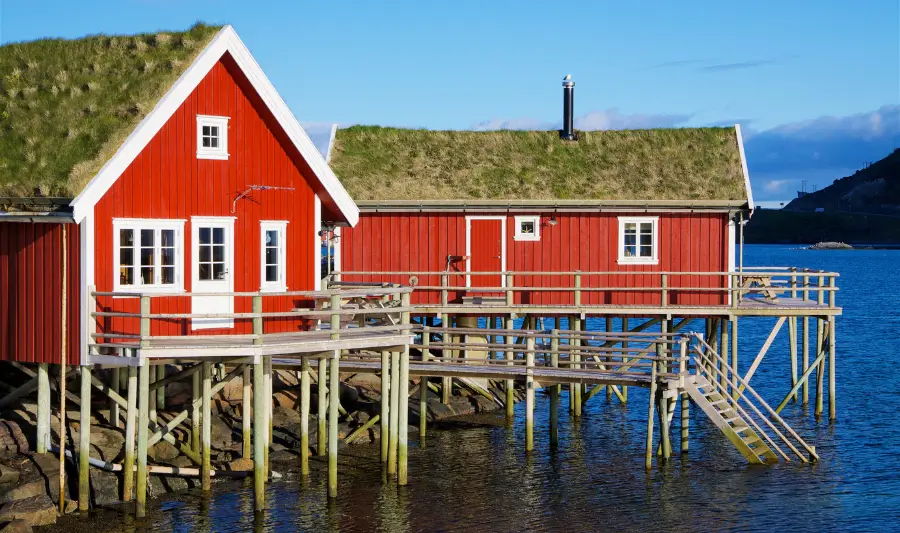
Best Time to Visit Lofoten Islands
All seasons are good for visiting the Lofoten Islands. Despite being a few hundred kilometers above the Arctic Circle, the Lofoten boast a pleasantly mild climate, thanks to the Gulf Stream that mitigates its shores. However, strong winds and rain are frequent, as well as snowfalls, which in winter make the landscape particularly suggestive and suitable for skiing.
However, the Lofoten Islands are one of those destinations in Norway that are worth visiting in both winter and summer, as the scenery and things to do can be vastly different. In winter you can try to spot the Northern Lights – the Lofoten Islands offer some of the most mind-blowing landscapes to see and photograph them – and enjoy its most intimate atmosphere. In summer it will never get dark, so you can enjoy the long days, the Midnight Sun, and the best outdoor activities. The shoulder seasons, spring and autumn, offer a good compromise, with few tourists and a pleasantly relaxed atmosphere.
Lofoten Islands in Winter
The Lofoten Islands in Winter are a magical place: snow-covered landscapes, desolate beaches and crystal fjords. The Northern Lights dance in the skies, skimming high peaks and sleeping landscapes covered with fish drying racks. The villages seem asleep, the lights filter through the rorbuer windows reflecting on the dark waters of the fjord. It looks like a nativity scene, a wonderful, unforgettable landscape that will whet your desire for the Far North.
Winter in the Lofoten Islands is not as harsh as you might think. From November to March, the average temperatures oscillate between -10 and + 5 °C, rather mild if compared with those of the hinterland, which easily drop below -20 °C. However, the wind can be very strong, which can cause you to feel more cold. Wind and humidity cause a perceived temperature lower than the real one, it is the so-called windchill effect. Keep this in mind and dress warm, with good waterproof clothes and hiking shoes, waterproof windbreaker and some nice woolen sweaters, as wool is a good natural insulator and doesn’t start to smell after just a few hours.
Between December and early January is the polar night season, so the sun will never rise above the horizon. Then, you will have to make the most of the few hours of twilight, which is enough to enjoy the landscapes of the Lofoten Islands. Winter driving in the Lofoten Islands is easy, as the best car rentals equip their cars with suitable tires. Anyway, go slow and enjoy the views!
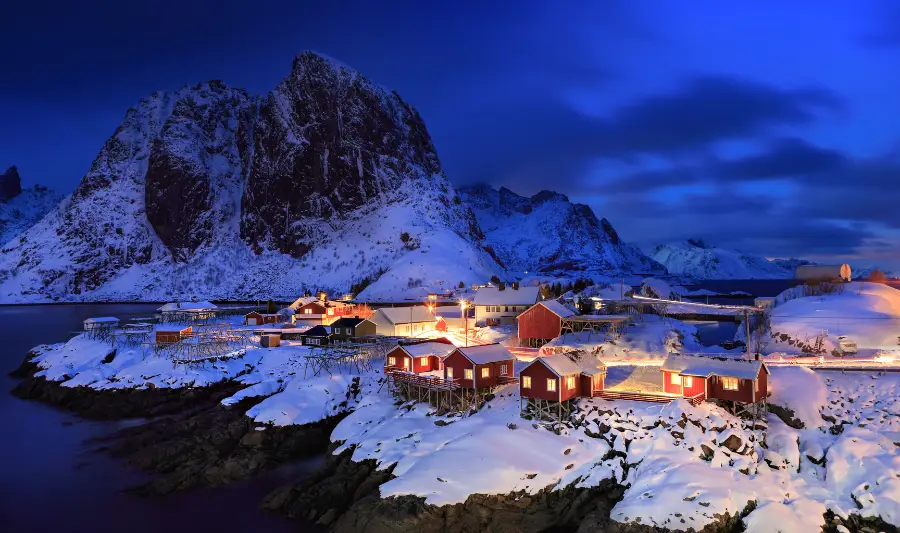
If you do not feel confident driving on the icy roads of Norway or if you are short on time, you could opt for one of the affordable guided tours of the Lofoten Islands, which in just 2 days will allow you to see the most beautiful places. Or you could book one of the tours to see the Northern Lights, as this is the best time to see them.
Around the villages of the Lofoten Islands in winter you will be able to see dozens of fishing boats and hundreds of fishermen, as this is the main season for cod fishing! Fishermen come here from all over Norway, and the fish drying racks are starting to fill up with cod. The mountains of the Lofoten Islands offer good opportunities for skiing and snowshoeing, while those who just want to relax and enjoy the magical atmosphere of the Lofoten Islands could stay in one of its beautiful traditional resorts – such as Nusfjord Arctic Resort, Hattvika Lodge and Nyvågar Rorbuhotell – to enjoy the best of local food and relax in the sauna or hot tub under the starry sky.
Lofoten Islands in Summer
In summer you can fully enjoy the Lofoten Islands! This is the best season for hiking, cycling, nature walks, boat tours, wilderness camping, fishing and more! It is no coincidence that this is the most popular season, and that the Lofoten Islands in the summer can be quite crowded and touristy!
The Lofoten Islands are a popular destination for backpackers, couples, families and cruise passengers in the summer, as some of Norway’s best cruises make a stop on the archipelago. Also, this is the best season for a Lofoten Islands road trip! So be warned that it is highly advisable to book accommodation, car rentals and tours well in advance!
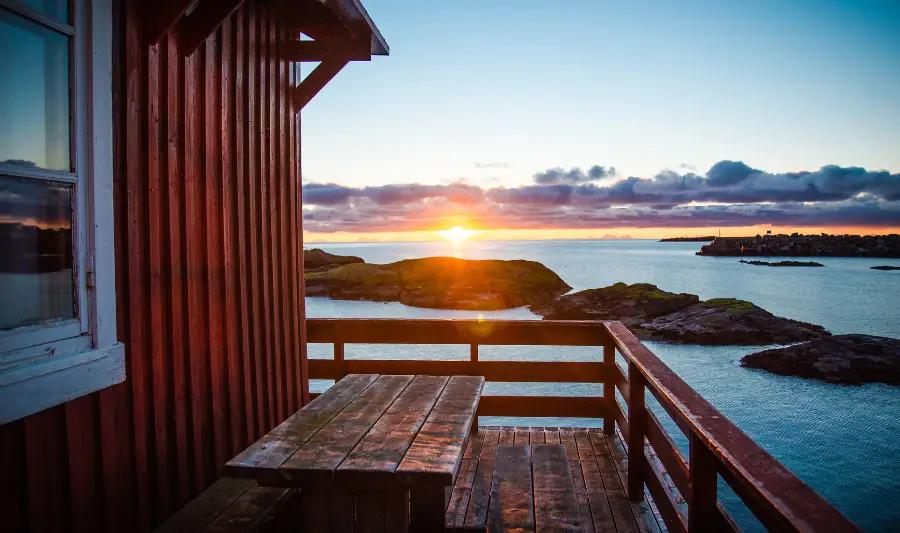
Visiting the Lofoten Islands in the summer will allow you to enjoy very long days, as between July and mid-August it will never be dark. You will be able to see the Midnight Sun and make the most of all outdoor activities: kayaking, surfing, mountain biking and horseback riding. In addition, all museums and shops will be open, as most only open in the summer. In summer you can virtually do everything in this guide!
The snow will be mostly melted and the hiking trails will be open and safe. This is the perfect season for boat tours to the breathtaking Trollfjord, where you can see sea eagles and many other seabirds. You will also be able to enjoy pleasantly mild temperatures, as average temperatures fluctuate between 12 and 17 °C, and in some recent years it has even reached 25 °C. Dress in layers, especially for hiking, bring good waterproof hiking boots and a waterproof windbreaker, as the weather changes abruptly. Summer in the Lofoten Islands can be said to be over as early as mid-August, when the days get shorter and the temperatures become autumnal.
Lofoten Islands in Autumn
Fall is a great season to visit the Lofoten Islands, as there won’t be many tourists around, but temperatures are still acceptable for enjoying the outdoors. The landscape slowly turns towards autumnal colors, offering suggestive sceneries characterized by meadows and forests in yellow and red hues.
This is also the wettest period, the days are getting shorter and many museums, shops and restaurants will be closed. However, the fares will be slightly more affordable, and it will still be enjoyable to walk around and admire the fabulous landscapes of the Lofoten Islands. This is the favorite season for photographers: zero crowds and a surreal atmosphere! With no snow yet, you may still enjoy many of the best hikes in the Lofoten Islands. And from November, if you’re lucky enough, you might see the Northern Lights.
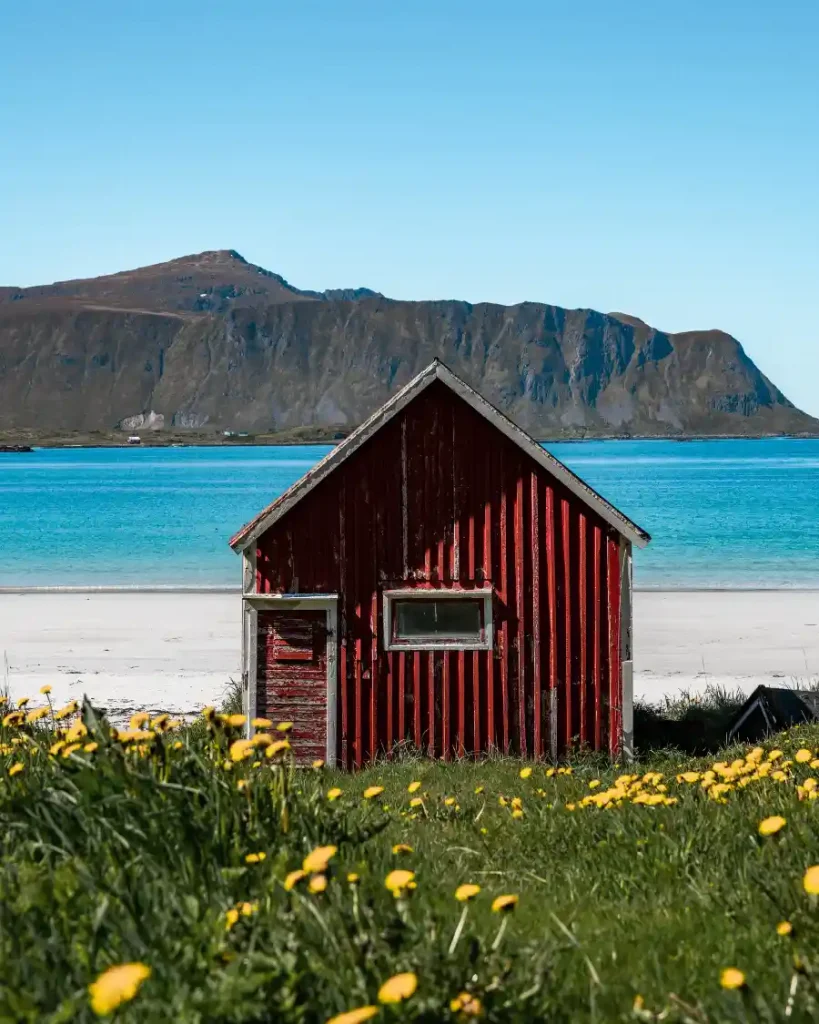
Lofoten Islands in Spring
Green flowery valleys, fabulous waterfalls, a lively and authentic atmosphere, still devoid of the big crowds of summer – the Lofoten Islands in spring could be surprising. The snow begins to melt and along the slopes you can see dozens of waterfalls, while the clear spring skies offer crazy views.
Photos of the Lofoten Islands with blue skies, bright green lawns and red houses that contrast with the emerald hues of the ocean are mostly taken in spring. This is the best season to see the fish drying racks filled with stockfish, to enjoy beautiful nature walks and for mountain biking. It could still be quite cold, and the snow inland won’t melt until late June or early July. However, it is unlikely that it will drop below freezing, as average temperatures fluctuate between 1 and 10 °C.
The days will get longer and longer, and as early as the end of May you will be able to enjoy the Midnight Sun. The Lofoten Islands are very beautiful this season, have a peaceful atmosphere and idyllic landscapes, with the snow-capped mountains as a backdrop to the villages. You won’t find many tourists around, and in late spring you can safely start enjoying some of the main hiking trails again.
Lofoten Islands Daylight Hours: Sunrise and Sunset Calendar
The Lofoten Islands are located above the Arctic Circle, so you can experience polar nights and the midnight sun, depending on the season. Especially for Lofoten Islands hiking, you may be wondering how many daylight hours there will be in the month you visit the Lofoten Islands. Here you will find some approximate sunrise and sunset times:
Lofoten Islands in January
01/01: The sun is always down
15/01: 10:36 – 13:58
Lofoten Islands in February
01/02: 09:21 – 15:20
15/02: 08:22 – 16:20
Lofoten Islands in March
01/03: 07:24 – 17:15
15/03: 06:25 – 18:07
Lofoten Islands in April
01/04: 06:14 – 20:08
15/04: 05:14 – 21:08
Lofoten Islands in May
01/05: 04:02 – 22:07
15/05: 02:51 – 23:16
Lofoten Islands in June
01/06: The sun is up all day
15/06: The sun is up all day
Lofoten Islands in July
01/07: The sun is up all day
15/07: The sun is up all day
Lofoten Islands in August
01/08: 03:27 – 23:00
15/08: 04:30 – 21:53
Lofoten Islands in September
01/09: 05:36 – 20:38
15/09: 06:26 – 19:39
Lofoten Islands in October
01/10: 07:22 – 18:32
15/10: 08:12 – 17:33
Lofoten Islands in November
01/11: 08:19 – 15:22
15/11: 09:21 – 14:23
Lofoten Islands in December
01/12: 10:43 – 13:10
15/12: The sun is always down
The midnight sun season on the Lofoten Islands is essentially from the end of May to the end of July. From April to August the days are long, sunny and pleasantly mild. This is the best time for hiking the Lofoten Islands.
Polar night on the Lofoten Islands is not that long, as it lasts from mid-December to early January. From November to early February, the days are short and rather dark. It can be rainy and windy, snowfalls are common. You will be able to enjoy a suggestive atmosphere, with a fairytale snowy landscape.
Winter temperatures on the Lofoten Islands are not as cold as you might expect, as they range between -2 and 3 °C. In summer, the days are pleasantly mild and fluctuate between 12 and 16 °C. In summer, especially for hiking the Lofoten Islands, it is important to dress in layers. Bring a good windbreaker!
However, during the polar nights you will have enough light to see the landscapes, drive along the scenic roads of the Lofoten Islands and take amazing shots. This is because it won’t be totally dark, but there will be the so-called Polar Twilight, similar to the light you can normally see at dawn.
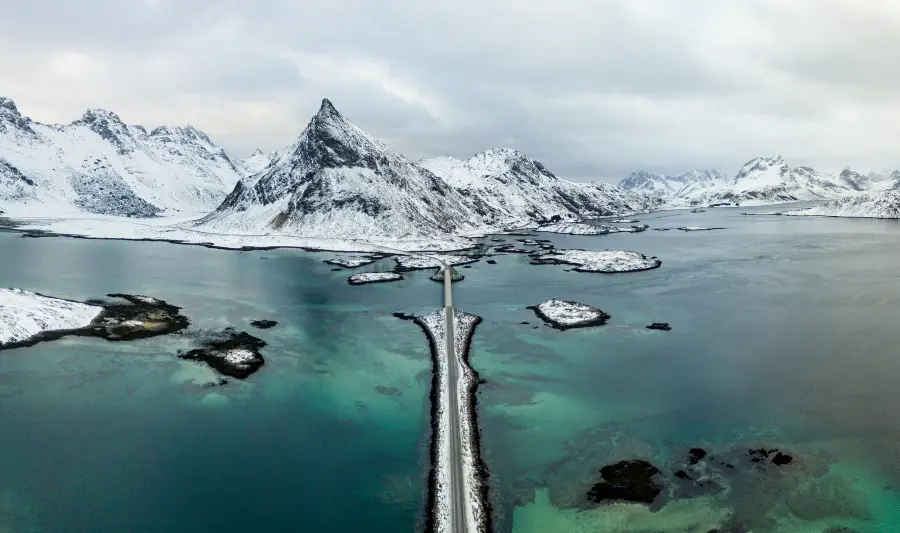
How to get to the Lofoten Islands
The best way to visit the Lofoten Islands is by car, making the archipelago one of the most popular fly and drive destinations in Norway. The local bus network is not suitable for tourists, as the rides are infrequent. From the Raftsund Bridge, which is the northeastern gateway to the Lofoten Islands and the start of the Lofoten Scenic Route (E10) to Å i Lofoten, it is 179 km, not counting the many detours to visit the most beautiful places. Therefore, having your own car is the best way to visit the Lofoten Islands at its best. The same goes for RVs and campervans, of course!
Unless you are taking a wonderful road trip through Norway with your car, you should rent a car in the Lofoten Islands, or in Bodø or at Harstad Narvik Airport. By booking in advance, car rental rates could be surprisingly affordable, starting at just NOK 330 or € 33 per day. In high season a good deal could be around NOK 600 or € 60 per day, but trust me, book early and you will get good prices. You can find the best car rentals and the best rates on Rentalcars (owned by Booking.com) or Discovercars.
Getting to the Lofoten Islands by Plane
There are two main airports on the Lofoten Islands, Svolvær Airport and Leknes Airport, which have some domestic connections operated by Widerøe.
- Svolvær Airport: has flight connections with Bodø (25 min, starting from NOK 498 one way), on the mainland, and with the small island of Røst (30 min, starting from NOK 699 one way). From Bodø there are frequent flights to and from Oslo, Tromsø and Bergen. Svolvær Airport is located 5km from the city center and there are no buses, so you will need to take a taxi (around NOK 150) or rent a car on the spot. You can check rates and availability on Rentalcars or Discovercars.
- Leknes Airport: has connections to Bodø (25 min, starting from 498 NOK one way). The airport is 2km from the city center, there are no buses here either, so you will need to take a taxi or rent a car.
Another popular airport is Harstad Narvik Airport, located 165 km – about 3 hours drive – northwest of Svolvær. The airport is located along the E10, so you could hire a car there for a full road trip of the Lofoten Islands. From here you can easily explore all the Lofoten Islands, but also the neighboring Vesterålen Islands. You can check the rates and book your car rental on Rentalcars or Discovercars.
From Harstad Narvik Airport there is also a bus to Svolvær city center, operated by Nor-way (2 hours 45 min, starting from NOK 449 one way). The airport has frequent flight connections with major cities in Norway.
A popular alternative is to fly to Bodø, which is the region’s main airport, and then take the car ferry to Moskenes. You will find more details below, in the section “Getting to the Lofoten Islands by Ferry”.
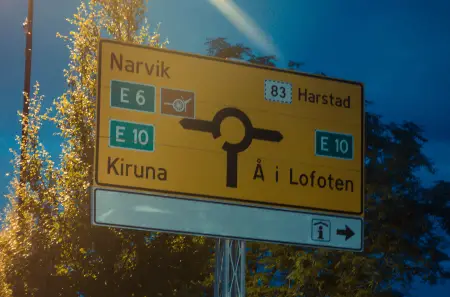
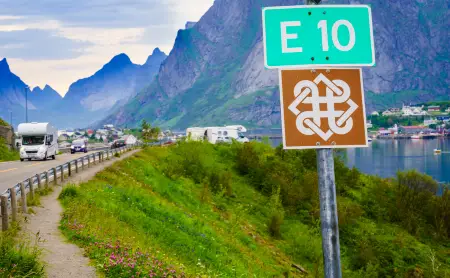
Getting to the Lofoten Islands by Car
With the exception of the more remote islands of Værøy and Røst and the small island of Skrova, all the main islands of Lofoten are easily connected by bridges and submarine tunnels. Road E10, also known as Norwegian Scenic Route Lofoten, is considered to be one of the most beautiful scenic roads in Norway. It is a wide road, in excellent condition (even in winter) and free of tolls, which crosses the entire archipelago from northwest to southeast.
The main detours to the most beautiful villages are well marked along the road, as are the main viewpoints, at which it is common to find a parking lot with toilets. Those who want to get to the Lofoten Islands by car can do it easily, as a road bridge connects them to the Vesterålen Islands and from there it is easy to get to the mainland, always by road bridges and without the need to leave the E10. The nearest town is Narvik, which is conveniently located for continuing to Tromsø or Sweden’s fabulous Lapland villages, such as Abisko and Kiruna. Or, from Narvik you can follow the E6 which will take you to Bodø.
You can also get to the Lofoten Islands by car by taking a car ferry from Bodø (all year), Bognes (all year), or Skutvik (summer only).
Getting to the Lofoten Islands by Bus
There are buses to Svolvær from Narvik, Bodø or Harstad Narvik Airport. A direct bus from Narvik will take you to Svolvær city center in about 4 hours (385 NOK). In Narvik the buses leave from the Bus Station next to the Amfi Narvik shopping center. From Bodø you can take a bus to Lødingen (approx. 5.5 hours, from NOK 428) and from there change to Svolvær (2 hours, from NOK 170).
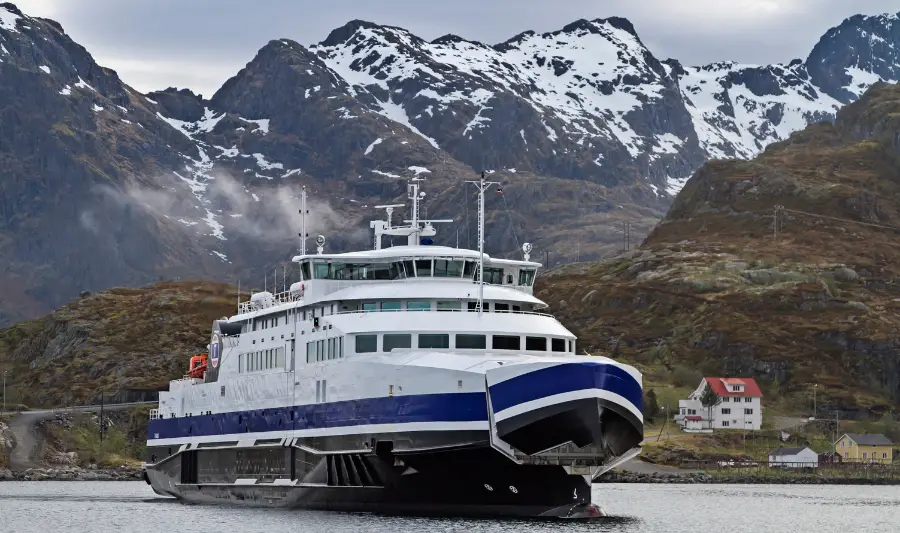
Getting to the Lofoten Islands by Ferry
A popular way to get to the Lofoten Islands is by ferry, especially for those traveling with their own car, RV or campervan. However, it is a cheap and popular way for backpackers from Bodø too.
Car ferries from Bodø to the Lofoten Islands
From the port of Bodø there are 3-4 car ferries per day (1-2 in winter) to Moskenes, a village located on the southwestern coast of the Lofoten Islands, near Å. These are large car ferries, capable of also transporting RVs and campervans, as well as passengers without cars. It takes about 3.5 hours. Tickets from NOK 200 for passengers without a car and NOK 954 for a car, including driver. From Bodø there are also express ferries (passenger only) to Svolvær (approx. 3.5 h, from NOK 385).
Getting to the Lofoten Islands in Hurtigruten
The coastal express Hurtigruten ships call the ports of Svolvær and Stamsund on the Lofoten Islands daily. Although many travelers travel the Hurtigruten as a cruise, along its entire route, the ships also allow port-to-port travel. Tickets are significantly more expensive than ferries, but the journey is very nice. Some ships can also carry cars, but you will need to inquire with the shipping company in advance. Usually Hurtigruten ships along the northbound route sail from Bodø at 3pm and arrive at Stamsund at 7pm and Svolvær at 9pm.
Car Ferries from Skutvik to the Lofoten Islands
To avoid traveling the E10 twice, once to go and once to return, you could opt for one of the ferry terminals located in the northwestern part of Lofoten, so that you can only travel one way, from there to Moskenes or vice versa. The most popular option is the car ferry to or from Skutvik, located roughly halfway between Bodø and Narvik. The ferry operates in summer only, and takes approximately 1.5 hours to get to Svolvær. Timetables and info here.
Car ferries from Bognes to the Lofoten Islands
A good alternative to the ferry to Skutvik is the one that goes between Bognes and Lødingen. The village of Bognes is located about 60km further north of Skutvik, while Lødingen is 100km northwest of Svolvær on the island of Hinnøya. It is easily reached by the E10 and will allow you to travel all the Lofoten Islands, up to the neighboring Vesterålen Islands. The car ferry to and from Bognes runs all year round and takes approximately 1 hour. It goes approximately every 1-2 hours, tickets from 433 NOK per car.
Lofoten Islands Map
This Lofoten Islands Map is the most detailed, and can be useful for planning your hikes and road trips in the best possible way. These are the official maps drawn and constantly updated by Kartverket, the Norwegian mapping authority.
You will be able to freely use these maps. You will also be able to print them, as these are the official maps that retailers print and sell online and in bookstores.
FAQs about the Lofoten Islands
Do you need a car in the Lofoten Islands?
The short answer is yes. You could also visit the Lofoten Islands without your own car, but you would be very limited. Local buses aren’t meant for tourists, so they’re not that frequent. Hitchhiking in the Lofoten Islands is popular among backpackers, but it may take some time, especially in winter (not recommended!).
So, having your own car in the Lofoten Islands is a big plus, as you can freely explore the villages, enjoy the best hikes and visit the most scenic spots at your own pace. Renting a car in the Lofoten Islands could be quite inexpensive, as fares start from NOK 330-350 NOK (approx. € 33-35) per day. So why not?
It is highly advisable to book your car hire well in advance. You can check prices and availability on Rentalcars or Discovercars, which offer the best rates from the best car rentals.
How long does it take to drive through the Lofoten Islands?
The Lofoten Scenic Road, which crosses the archipelago from northeast to southwest, takes 3-3.5 hours. But you’ll want to stop tons of times to enjoy its stunning scenery, so it’ll take you at least a full day. Most of the nicer villages and major sights require some detours from the E10 Lofoten Scenic Road, so just driving through won’t be enough.
How many days do you need to visit the Lofoten Islands?
If you just want to drive through and enjoy the views along the way, this is doable in one day (in the summer, as you will have fewer daylight hours to visit in the winter), but I wouldn’t recommend it. Why? Simple, you wouldn’t see anything! It will be just a strenuous race from one viewpoint to another.
The Lofoten Islands well deserve time: to enjoy the views, take great photos, visit villages and museums, stay in a fishing village, take some boat trips. This means visiting Lofoten! And this will take anywhere from 3 days to 1 week. If you want to do some hikes or outdoor activities, then you will need at least 10 days.
Do you need travel insurance in the Lofoten Islands?
Yes, absolutely! While having travel insurance is not a legal requirement if you are a European citizen, it is strongly recommended. Norway is not an EU country, so your European health insurance may not be valid or may not cover all costs.
When traveling in the Arctic, especially if you are planning to do outdoor activities, hiking, nature walks etc., it is essential to have good health insurance, so that you can enjoy the trip carefree. Health costs in the event of an accident or injury in Norway could be very high, as well as those of medical transport and search and rescue. Hence, a travel insurance is highly recommended!
Travel health insurance is a mandatory requirement for non-EU citizens, who need to apply for a Schengen visa to visit Norway and the Lofoten Islands.